TVC 2015, 2015-6
“Incompressibility-Preserving Deformation for Fluid Flows Using Vector Potentials"
by Syuhei Sato, Yoshinori Dobashi, Yonghao Yue, Kei Iwasaki, Tomoyuki Nishita
Abstract
Physically-based
uid simulations usually re-
quire expensive computation cost for creating realistic
animations.We present a technique that allows the user
to create various
uid animations from an input
uid
animation sequence, without the need for repeatedly
performing simulations. Our system allows the user to
deform the
ow �eld in order to edit the overall
uid
behavior. In order to maintain plausible physical be-
havior, we ensure the incompressibility to guarantee the
mass conservation. We use a vector potential for repre-
senting the
ow �elds to realize such incompressibility-
preserving deformations. Our method �rst computes
(time-varying) vector potentials from the input veloc-
ity �eld sequence. Then, the user deforms the vector po-
tential, and the system computes the deformed velocity
�eld by taking the curl operator on the vector potential.
The incompressibility is thus obtained by construction.
We show various examples to demonstrate the useful-
ness of our method.
Key worlds;
flow deformation, incompressibility, vector potential
Additional information
TVC 2014, 2014-12
“Volume preserving viscoelastic fluids with large deformations
using position-based velocity corrections"
by Tetsuya Takahashi, Yoshinori Dobashi, Issei Fujishiro, Tomoyuki Nishita
Abstract
We propose a particle-based hybrid method
for simulating volume preserving viscoelastic fluids with
large deformations. Our method combines smoothed particle
hydrodynamics (SPH) and position-based dynamics (PBD)
to approximate the dynamics of viscoelastic fluids. While
preserving their volumes using SPH, we exploit an idea of
PBD and correct particle velocities for viscoelastic effects
not to negatively affect volume preservation of materials. To
correct particle velocities and simulate viscoelastic fluids,
we use connections between particles which are adaptively
generated and deleted based on the positional relations of
the particles. Additionally, we weaken the effect of velocity
corrections to address plastic deformations of materials. For
one-way and two-way fluid-solid coupling, we incorporate
solid boundary particles into our algorithm. Several examples
demonstrate that our hybrid method can sufficiently preserve
fluid volumes and robustly and plausibly generate a variety
of viscoelastic behaviors, such as splitting and merging, large
deformations, and Barus effect.
Key worlds; Fluid simulation ・ Viscoelasticity
Additional information
IEVC 2014, 2014-10
“Visual Simulation of Glazed Frost Taking into Accoun Supercooled State"
by Tomokazu Ishikawa, Yonghao Yue, Taichi Watanabe, Kei Iwasaki, Yoshinori Dobashi, Masanori Kakimoto, Kunio Kondo, Tomoyuki Nishita
Abstract
We propose a method for simulating glazed frost by computing heat transfers between water droplets and the surrounding air. Motions of air and water droplets are computed based on a FLIP (Fluid-Implicit-Particle)-based fluid solver. Glazed frost is a crystal clear ice and formed from supercooled raindrops that freeze when they hit object surfaces. We propose a method to create an animation of glazed frost formation by taking into account the heat transfer between particles and the out-side grids. The time to freeze is calculated by consider-ing the heat flux on the surface of the raindrop until freezing from the adhesion on the obstacles. We propose a technique which is highly compatible for a FLIP method to solve the heat conduction equation and we reproduce the formation of glazed frost.
Key worlds;
Additional information
|
|
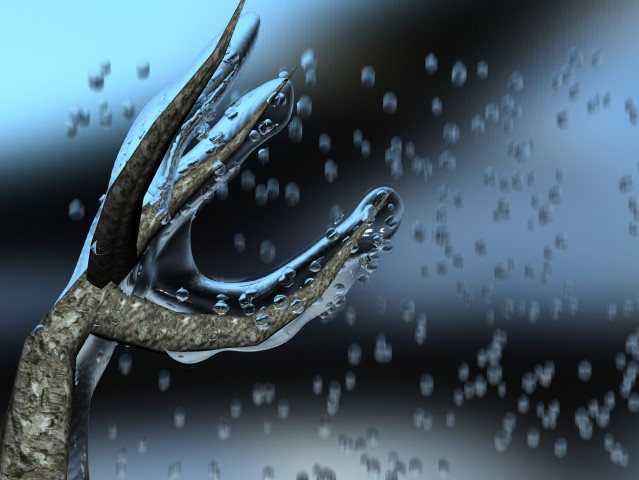
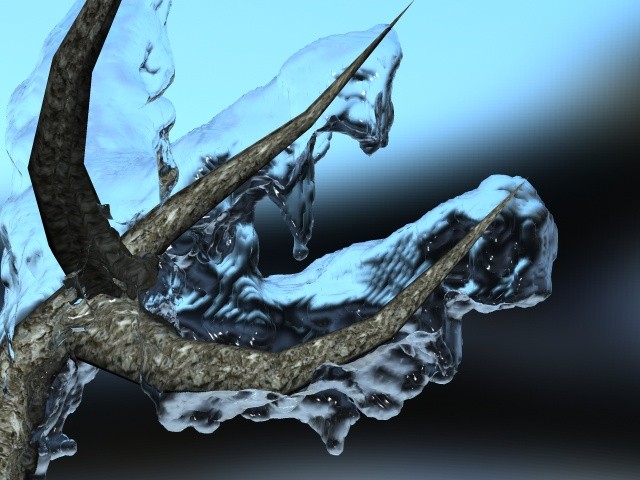
|
Computer & Graphics 2014, 2014-7
“Fast simulation of viscous fluids with elasticity and thermal conductivity using position-based dynamics
"
by Tetsuya Takahashi, Issei Fujishiro, Tomoyuki Nishita
Abstract
Viscous fluids are ubiquitous, and reproducing their damped motions has been in demand for many applications. The most prevalent approach to simulating viscous fluids is based on the Navier?Stokes equations and necessitates viscosity integration. However, to simulate viscous fluids in a numerically stable manner, using explicit viscosity integration severely restricts time steps and requires an excessively long period for computation. In this paper, we propose a novel particle-based Lagrangian method for efficiently simulating viscous fluids by adopting position-based constraints. Our method uses the geometric configuration of particles for the positional constraints to approximate the dynamics of viscous fluids using position-based dynamics; thus the method can plausibly generate their motions while allowing for the use of much larger time steps than those previously adopted in the viscous fluid simulations. We also propose an associated boundary-handling scheme for position-based fluids to precisely specify boundary conditions for the constraints. Additionally, we reproduce elastic deformations of materials by controlling the constraints and incorporate thermal conduction into our framework to simulate resultant changes in particle properties and phase transition in the materials. By adjusting parameters, our method can encompass complex motions of fluids with different properties in a unified framework. Several examples demonstrate the effectiveness as well as versatility of our method.
Keywords:
Fluid simulation; Viscous fluid; Position-based dynamics; Geometric constraint; Elasticity; Thermal conductivity
Additional information
|
|
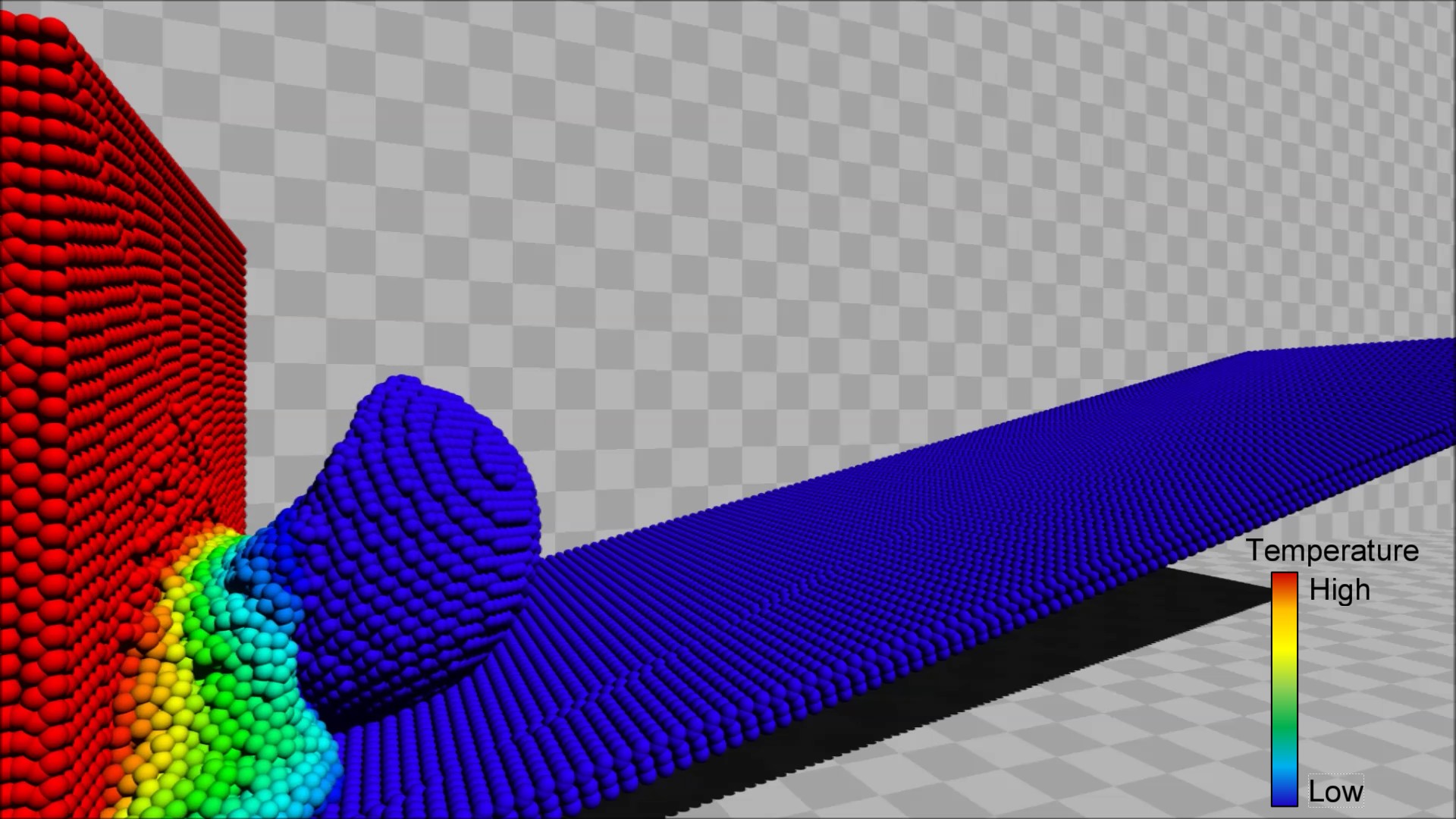
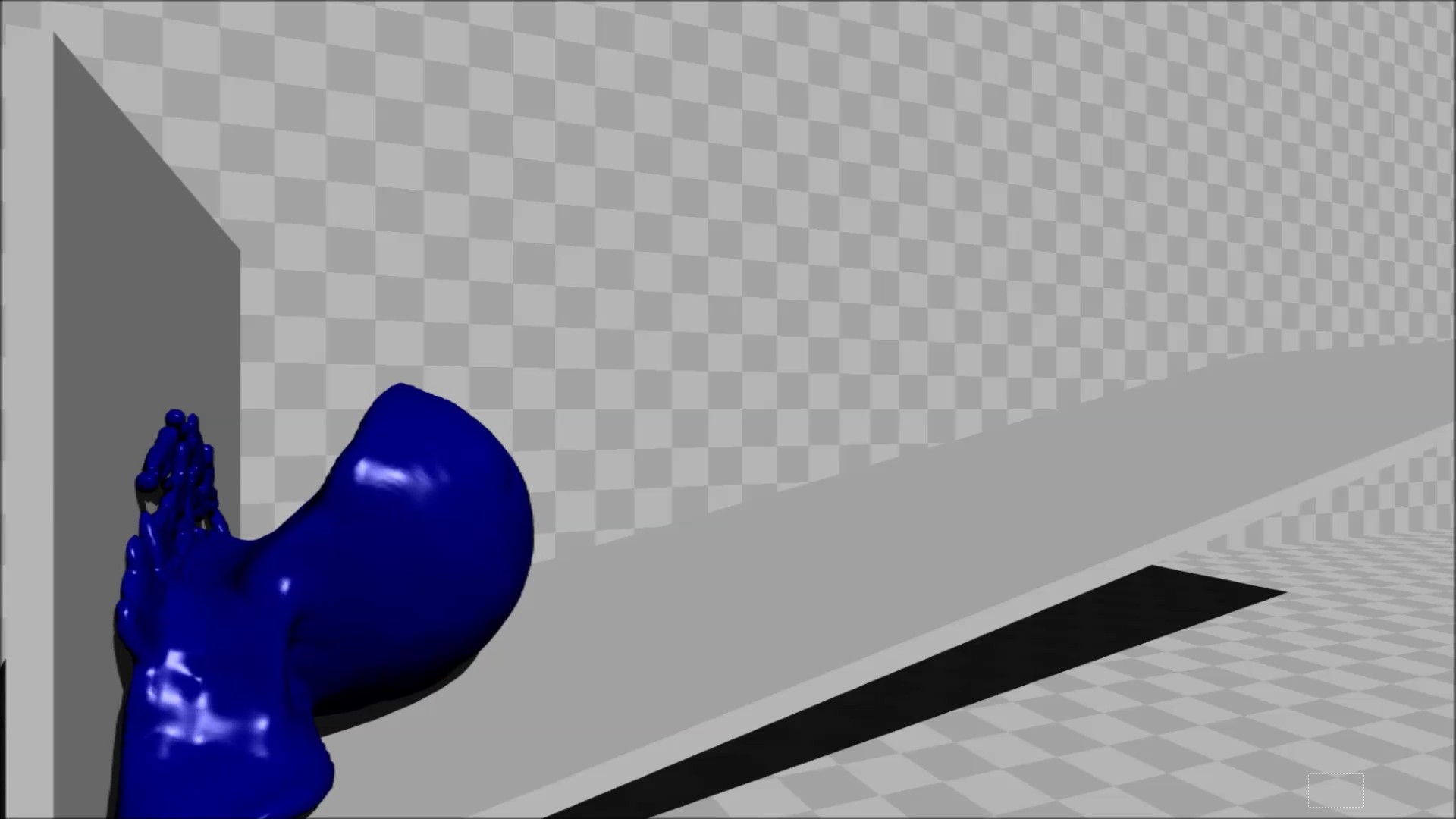
|
CGI 2014, 2014-6
“A Velocity Correcting Method for Volume Preserving Viscoelastic Fluids"
by Tetsuya Takahashi, Issei Fujishiro, Tomoyuki Nishita
Abstract
We propose a new particle-based method for simulating viscoelastic
fluids which preserve their volumes. Our method achieves the volume
preservation by enforcing the incompressibility of fluid, while
correcting particle velocities to approximate the dynamics of
viscoelastic fluids without disturbing computations for the
incompressible flow. We offer three schemes for correcting particle
velocities. The first scheme employs Shape Matching proposed by
M\"uller et al. to derive appropriate transformations of particle
sets. The second computes attraction forces on the basis of Hooke's
law to restrict particle motions. The third utilizes Position-Based
Dynamics to restore the original relations of particle positions. The
first scheme enables smooth transfers of deformation waves, the second
is intuitive and simple, and the third is easy to tune parameters. We
demonstrate that our method can preserve fluid volumes while
generating plausible viscoelastic motions.
Additional information
NICOGRAPH International 2014, pp.35-42, 2014-6
“Visual Simulation of Compressible Snow with Friction and Cohesion"
by Tetsuya Takahashi, Issei Fujishiro, Tomoyuki Nishita
Abstract
Recent advances in physically-based simulation have made it possible
to simulate various kinds of natural phenomena. However,
characteristic behavior of accumulated snow while being compressed due
to pressure has been insufficiently simulated merely with a height
field approximation. In this paper, we propose a new method for
simulating compressible snow by approximating snow as a set of porous
snow particles. We introduce a new parameter called durability for
each porous snow particle, which represents the rate of undamaged snow
structures. The compression of accumulated snow is achieved by
absorbing the impact
from solids on the snow by taking the durability of snow particles
into account. In addition to the compressibility, we incorporate
friction and cohesion into our simulation framework to represent
various effects of accumulated snow. For enhanced visual reality, fine
scale simulations are performed as a post-processing. Several examples
demonstrate the versatility of our method.
Additional information
IIEEJ Transactions on Image Electronics and Visual Computing (T-IEVC), Vol.1,No.1, 2013-12
“Visual Simulation of Magnetic Fluids Using Dynamic Displacement Mapping for Spike Shapes"
by Tomokazu Ishikawa, Yonghao Yue, Kei Iwasaki, Yoshinori Dobashi, Tomoyuki Nishita
Abstract
Although several simulation methods have been proposed to analyze the
behavior of magnetic fluids in the computational physics field, it is
still not reasonably tractable to simulate the spiking phenomenon
using fully physically based methods. To synthesize spike shapes, a
procedural approach has been proposed in the computer graphics field
recently for visual simulation, which, however, cannot simulate
dynamic arrangement and deformation of spikes since the spike shapes
are determined beforehand. To overcome this drawback, we propose an
improved model to incorporate the dynamic behavior of the spikes. The
model is based on the assumption that the spikes are attracted by an
external magnetic field and that each spike repels the others because
of their magnetization. The position of the spikes on the liquid
surface are determined in the simulation, and the spike shape is
mapped according to the direction of the magnetic field lines. The
coordinates at which the spike protrudes from the liquid surface are
calculated in the fluid simulation.
Additional information
HPG13
“Efficient Divide-And-Conquer Ray Tracing using Ray Sampling"
by Kosuke Nabata, Kei Iwasaki, Yoshinori Dobashi, Tomoyuki Nishita
Abstract
Divide-and-conquer ray tracing (DACRT) methods solve intersection problems between large numbers of rays and primitives by recursively subdividing the problem size until it can be easily solved. Previous DACRT methods subdivide the intersection problem based on the distribution of primitives only, and do not exploit the distribution of rays, which results in a decrease of the rendering performance especially for high resolution images with antialiasing. We propose an efficient DACRT method that exploits the distribution of rays by sampling the rays to construct an acceleration data structure. To accelerate ray traversals, we have derived a new cost metric which is used to avoid inefficient subdivision of the intersection problem where the number of rays is not sufficiently reduced. Our method accelerates the tracing of many types of rays (primary rays, less coherent secondary rays, random rays for path tracing) by a factor of up to 2 using ray sampling.
Additional information
Proc. of IEVC. 2012, 2B-3, 2012-11
“Efficient image registration for cartoon animation"
by Pablo Garcia Trigo , Yoshihiro Kanamori, Sei Imai, Yonghao Yue, Tomoyuki Nishita
Abstract
Image registration is a fundamental technique that
finds correspondences between two images and plays
an important role in automating the production of 2D
hand-drawn animations. However, previous methods
for image registration are slow due to the high num-
ber of searches used to find correspondences, reducing
their utility. In this paper, we propose a method for
accelerating the image registration of 2D hand-drawn
animations. The key idea is to use random searches and
propagate good correspondences to reduce the number
of comparisons. Our experiments demonstrate that our
method achieves a speedup of more than eight times
without sacrificing the matching quality.
Additional information
Proc. of IEVC. 2012, 2B-5, 2012-11
“Simulating plant color aging taking into account the sap flow in the venation
"
by Paulo Silva, Yonghao Yue, Bing-Yu Chen Tomoyuki Nishita
Abstract
Additional information
|
|

|
Proc. of IEVC. 2012, 4B-1, 2012-11
“Face detection and face recognition of cartoon characters using feature extraction
"
by Kohei Takayama, Henry Johan, Tomoyuki Nishita
Abstract
In this paper, we propose methods for face detection and face recognition of cartoon characters which appear in cartoons, comics, games, etc. These methods can be applied to various applications, such as character search, automatic character classification, and character image editing. Previous researches on face detection and face recognition of real people have been abundant, on the other hand, there are little researches on face detection and face recognition of cartoon characters. Using previous methods for real people, cartoon character faces can hardly be detected and recognized because the face features of cartoon characters differ greatly from those of real people in terms of size and shape. Our methods solve these problems by considering the face features of cartoon characters. Using our methods, face detection and face recognition for cartoon characters search can be performed with good accuracy.
Additional information
Proc. of IEVC. 2012, 5B-5, 2012-11
“Visual simulation of magnetic fluid taking into account dynamic deformation
in spikes"
by Tomokazu Ishikawa, Yonghao Yue, Kei Iwasaki, Yoshinori Dobashi, Tomoyuki Nishita
Abstract
In the physical field, several simulation methods for magnetic fluids
had been proposed to analyze magnetic fluids' behavior. However, from
their results, we estimate that it is difficult to simulate the spike
shapes using only fully physically-based methods.
Therefore in our previous work, we proposed the method which
synthesizes the spike shapes by employing the procedural approach for
visual simulation of magnetic fluids. Because the spike shape has been
determined beforehand, this method has a drawback, that this method
cannot simulate the dynamic arrangement and deformation of spikes.
To overcome this drawback, we propose a simulation model based on the
assumption that the spikes are attracted by an external magnetic field
and each spike repels each other by the magnetization of itself. The
coordinates of the conical undersurface centers of spikes on the
liquid surface are determined in the simulation and the spike shape is
mapped according to the direction of magnetic field lines.
Additional information
The journal of the Society For Art and Science, Volume.11, No.4 (Proc. of NICOKGRAPH Int. 2012, pp.83-93, 2012-7)
“Progressive Photon Beams with Adaptive Free Path Sampling"
by Kentaro Suzuki, Yonghao Yue, Tomoyuki Nishita
Abstract
Photo-realistic rendering of participating media, such as steam, water, fire, and smoke, is an important research topic in the computer graphics field. We present a fast and physically based method for rendering participating media based on the progressive photon beams method. For this, we propose a new version using adaptive free path sampling technique and applying a new estimation method for light transmittance functions based on stratified sampling, which overcomes the deficiencies in the progressive photon beams method. Our method is able to take into account not only single but also multiple scattering of light inside the participating medium. Using our method, participating media with complex density distributions can be handled, as well as complex lighting conditions. Additionally, we can obtain images which are guaranteed to converge to exact solutions. Moreover, our method is implemented on a GPU, enabling fast computation of the solutions.
Additional information
The journal of the Society For Art and Science, Volume.11, No.4, pp.118-128, 2012-12 (Proc. of NICOKGRAPH Int. 2012, pp.20-26, 2012-7)
“Visual Simulation of Bubbles in Carbonated Water"
by Yoshihiro Kanamori, Takeshi Nishikawa, Yonghao Yue, Tomoyuki Nishita
Abstract
In this paper, we propose a simple method for simulating the
generation, growth and motion of bubbles in carbonated water. Bubbles
are known to be generated at small air pockets on the surfaces of
objects, such as a glass or a stirrer, and on the microscopic dusts in
carbonated water. The number of bubbles and their growth rates differ
according to the materials of the objects. In addition, the motion of
bubbles also differs according to the materials; bubbles slowly glide
on plastic and acrylic surfaces whereas such motions cannot be seen on
a stainless-steel surface. Our method can represent such differences
by controlling the number of generation points (i.e., air pockets) and
applying adhesion forces to make bubbles stick on the surfaces.
Because bubbles in carbonated water are sufficiently small, our method
regards bubbles as non-deformable spherical particles. We simulate the
flow in carbonated water using a grid-based method, together with the
two-way coupling technique between bubbles and the convective flow.
Additionally, the collisions and fusions among bubbles are also
handled to reproduce the complex behavior of bubbles.
Additional information
Proc. of WSCG2012, pp.?, 2012-6
“Animation of Water Droplets on a Hydrophobic Windshield"
by Nobuyuki Nakata, Masanori Kakimoto, Tomoyuki Nishita
Abstract
Animation of water drops on a windshield is used as a special effect in advanced driving games and simulators.
Existing water droplet animation methods trace the trajectories of the droplets on the glass taking into account the hydrophilic or water-attracting nature of the glass material.
Meanwhile, in the automobile industry, usage of hydrophobic glass windshields has recently been a common solution for the drivers clear vision in addition to cleaning the water with wipers.
Water drops on a hydrophobic windshield behave differently from those on a hydrophilic one.
This paper proposes a real-time animation method for water droplets on a windshield taking account of hydrophobicity. Our method assumes each relatively large droplet as a mass point and simulates its movement using contact angle hysteresis accounting for dynamic hydrophobicity as well as other external forces such as gravity and air resistance.
All of a huge number of still, tiny droplets are treated together in a normal map applied to the windshield. We also visualize the Lotus effect, a cleaning action by the moving droplets. Based on the proposed simulation scheme, this paper demonstrates the motion of the virtual water droplets on the windshield of a running vehicle model.
Additional information
|
|

|
Proc. of GRAPP2012, pp.319-327, 2012-2
“Visual Simulation of Magnetic Fluids"
by Tomokazu Ishikawa, Yonghao Yue, Kei Iwasaki, Yoshinori Dobashi, Tomoyuki Nishita
Abstract
In this paper, we focus on simulation of magnetic fluids. Magnetic
fluids behave as both fluids and as magnetic bodies, and these
characteristics allow them to generate ‘spike-like’ shapes along a
magnetic field. Magnetic fluids are popular materials for use in works
of art. Our goal is to simulate such works of art. In the field of
electromagnetic hydrodynamics, many methods have also been proposed
for simulating such spike shapes based on numerical fluid analysis.
However, those methods are computationally expensive and they
typically require tens of hours just to simulate a single spike. We
propose a more efficient method by combining a procedural approach and
the SPH method (smoothed particle hydrodynamics). Our method simulates
overall behaviors of the magnetic fluids using the SPH method and then
synthesizes the spike shapes by using the procedural approach. We
demonstrate our method can generate visually plausible results within
a reasonable computational cost.
Additional information
Proc. of MIG 2011,In Proc. of Motion in Games 2011, Allbeck JM and Faloutsos P (Eds.), Lecture Notes in Computer Science (LNCS) 7060,, 2011-12
“Twisting, Tearing and Flicking Effects in String Animations"
by Witawat Rungjiratananon, Yoshihiro Kanamori, Napaporn Metaaphanon, Yosuke Bando, Bing-Yu Chen and Tomoyuki Nishita
Abstract
String-like objects in our daily lives including shoelaces, threads
and rubber cords exhibit interesting behaviors such as twisting, tearing
and bouncing back when pulled and released. In this paper, we present
a method that enables these behaviors in traditional string simulation
methods that explicitly represent a string by particles and segments. We
offer the following three contributions. First, we introduce a method for
handling twisting effects with both uniform and non-uniform torsional
rigidities. Second, we propose a method for estimating the tension acting
in inextensible objects in order to reproduce tearing and flicking (bouncing
back); whereas the tension for an extensible object can be easily
computed via its stretched length, the length of an inextensible object
is maintained constant in general, and thus we need a novel approach.
Third, we introduce an optimized grid-based collision detection for an
efficient computation of collisions. We demonstrate that our method allows
visually plausible animations of string-like objects made of various
materials and is a fast framework for interactive applications such as
games.
Additional information
Proc. of 2011, , 2011-12
“An interactive system for structure-based ASCII art creation"
by Katsunori Miyake, Henry Johan and Tomoyuki Nishita
Abstract
Non-Photorealistic Rendering (NPR), whose aim is to
create artistic style images, is one of the important research
topics in computer graphics. One example of NPR is an art
form called ASCII art which represents pictures using charac-
ter strings. ASCII art is commonly used in media that cannot
display images or mainly use text, such as e-mail and bulletin
board system. ASCII art can be categorized into two styles,
tone-based style and structure-based style. The structure-
based style can represent content by using less number of
ASCII characters compared to the tone-based style. However,
in general, it takes beginners a long time to create structure-
based ASCII art. As such, an automatic method that creates
structure-based ASCII art is required to reduce the tasks of
ASCII art creation.
In this paper, we propose an interactive system which cre-
ates structure-based ASCII art. We provide four matching
metrics for converting an image into an ASCII art.Based on
experimental results, we found that the suitable matching
metrics to produce visually pleasant ASCII art images de-
pend on the type of the input images. Since our system can
produce ASCII art images in a few seconds, users can create
several ASCII art images using different matching metrics,
then select the one they like the most.
Additional information
Proc. of SCCG2011, pp.69-76, 2011-4
“Interactive Texturing on Objects in Images via a Sketching Interface"
by Kwanrattana Songsathaporn, Henry Johan and Tomoyuki Nishita
Abstract
In this paper, we propose an interactive system for texturing objects
in images without reconstructing the full 3D models. To make
the texturing process easy for users, we emphasize on intuitiveness,
and our system lets users perform texturing via a sketching interface.
In addition, our system provides simple tools for specifying
occlusion and perspective of the texturing objects. To texture with
our system, first, with the sketching interface, users design the normal
vector fields of objects in images that they wish to paste textures
on. Next, to depict the shapes of the objects, the textures are
deformed according to the normal vector fields, and pasted in the
images over the objects. Once the textures are pasted on the images,
users can manipulate (move, scale and rotate) the textures, and see
the textures deformed interactively as if the textures were pasted on
3D models. The proposed system is tested with various kinds of
objects in images, and we show that our system supports texturing
with textures of regular, near-regular and irregular types.
Additional information
Best Paper Award
|
|

|
Proc. of SCCG2011, pp.77-82, 2011-4
“Local Optimization of Distortions in Wide-Angle Images
Using Moving Least-Squares"
by Yoshihiro Kanamori, Nguyen Huu Cuong and Tomoyuki Nishita
Abstract
We present a fast algorithm for reducing the undesired distortions
(e.g., bending of straight lines) that often appear in wide-angle
images especially taken with fisheye lenses. Our method allows the
user to intuitively specify curves to be straightened by using
quadratic control curves, and then automatically warps the image based
on moving least-squares (MLS) while minimizing distortions in
the vicinity of the curves. Unlike previous methods, our method
provides results instantly, and allows the user to manipulate curves
to obtain better results once after the initial solution is given. We
demonstrate the effectiveness of our method with a variety of
wide-angle images, together with comparisons to related projections.
Additional information
|
|
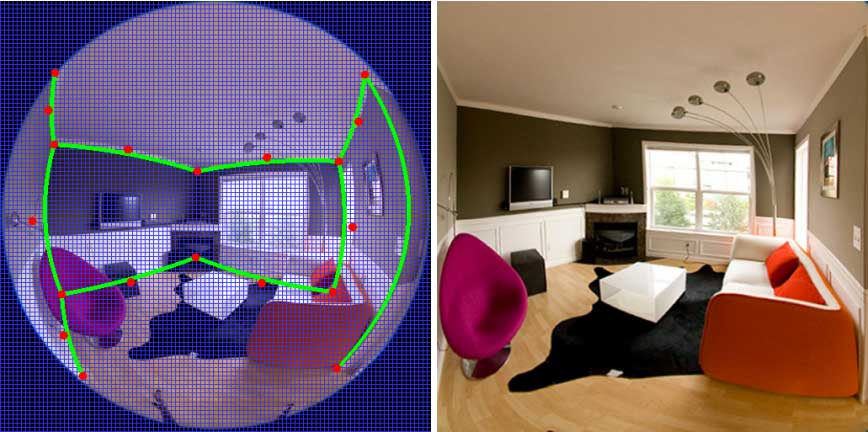
|
Proc. of SCCG2011, pp.35-38, 2011-4
“Modeling of Aurora Borealis Using the Observed Data"
by Tomokazu Ishikawa, Yonghao Yue,Kei Iwasaki, Yoshinori Dobashi and Tomoyuki Nishita
Abstract
In the field of Computer Graphics (CG), applications such as
movies and games benefit from realistic visualizations of atmospheric
phenomena because realistic visualizations increase applications’
attractiveness. Among the atmospheric phenomena, auroras
are some of the most beautiful phenomena, which makes their
visualization highly desirable for such applications.
Physically, the generation of auroras depends on the solar activity.
Since auroras can be observed only in high latitudes and their observation
depends on the weather condition, it is extremely rare to
observe auroras directly in nature. Therefore, modeling and visualizing
the aurora borealis using CG are important.
In previous visual simulation methods for aurora borealis, the fluctuations
and the curls of aurora are modeled by using a simple
model that treats the aurora as fluids and therefore does not reflect
the actual phenomena. One of the reasons for using such approximate
simulations is that the motions of the aurora borealis are not
fully understood yet among the researchers.
In this paper, we propose a model for visualizing the aurora borealis
using data gathered from satellite observations. The observed data
represents the electric fields and the distributions of Field-Aligned
Current (FAC) in high latitudes. By using the captured data and
simulating the virtual current circuits that take place in the ionosphere,
our method models the shapes of the aurora borealis. We
demonstrate that our simulation method can model time-varying
aurora borealis.
Additional information
The Journal of IIEEJ, Vol.40, No.1, pp.6-13, 2011-1
“Deterministic Blue Noise Sampling by Solving Largest Empty Circle Problems"
by Yoshihiro Kanamori, Zoltan Szego and Tomoyuki Nishita
Abstract
Sampling patterns with a blue noise distribution are widely used in many areas of computer graphics, yet their efficient generation remains a difficult problem.
We propose a method to generate point sets with a blue noise distribution using a deterministic algorithm with no preprocessing. We insert each new sample at the center of the largest empty circle in the point set, which is obtained by calculating the Delaunay-triangulation of the set and finding the triangle with the largest circumcircle. Our method supports adaptive sampling according to a user-specified density function, as well as specifying the exact number of required samples. It can also be extended to perform sampling on a three-dimensional curved surface.
Keywords
Blue noise sampling, Delaunay triangulation, halftoning
Additional information
The Journal of IIEEJ,Vol.40, No.1, pp.141-150, 2011-1
“Visual Simulation of Solar Photosphere Based on Magnetrohydrodynamics and Quantum Theory"
by T. Ishikawa, Y.Yue, Y. Dobashi, and Tomoyuki Nishita
Abstract
We propose an efficient method based on physical laws to model phenomena near the surface of the sun, which is known as the solar photosphere. In the field of astronomy, some physical models have been developed to simulate the sun’s turbulence. Most of the previous models are difficult to be applied in the making of CG images since they require a considerable amount of time even when using a supercomputer. The subject of our research is the visual simulation of the phenomena observed above the photosphere, namely solar prominences, because these are characteristic phenomena of the sun that can greatly influence the visual impact in movies and games.The sun is mainly composed of ionized plasma, and its behavior can be treated as a fluid. However, unlike gas, the plasma fluid is influenced by the magnetic field. Thus, magnetic field calculations are needed to calculate the plasma behavior. We use the magnetohydrodynamics (MHD) equations to simulate the behavior of plasma. We propose a new method which can simulate a prominence in a practical computation time. The computation cost is reduced by simplifying the phenomena inside the sun: we only consider the phenomena after the solar prominence erupts because the phenomena before the eruption dose not manifest itself in a visual way. To render the simulation results, we emulate an observation method that extracts the specific spectrum emission from the solar plasma.
Keywords
Additional information
The Journal of IIEEJ, Vol.40, No.1, pp.105-113, 2011-1
“Real-Time Line Drawing of 3D Models Taking Into Account Curvature-Based Importance"
by Shohei Wada, H. Johan, Pablo Garcia Trigo, and Tomoyuki Nishita
Abstract
Keywords
Additional information
Proc. of HC 2010, 2010-12
“Skeleton Extraction from a Mesh for Easy Skinning Animation"
by Martin Madaras, Roman Durikovic, Tomas Agoston, Tomoyuki Nishita
Abstract
This paper proposes the
extraction of a skeleton and skinning weights from a given mesh,
describes how to
store computed data in Collada 1.5 and use it for an animation. Firstly, the
mesh is contracted using constrained Laplacian smoothing in a few iterations.
Few vertices from the contracted mesh are chosen as control points.
Multiple edges are removed and vertices that are very close to each other are
merged using a greedy algorithm minimizing the energy. The greedy
selection is applied repeatable until we have the
tree structure with edges corresponding to bones. We also propose the
automatic assignment of the skinning weights that determine the rigid
or soft mesh deformations. In the postprocessing stage
the user can inspect the skeleton by previewing skinning deformations, make
desired changes and export the skeleton to Collada 1.5. Transformation
matrices used in a
hierarchical skeleton tree are not transformed to joint's local transformation
frame, so they are immediately compatible with majority of animation software
and libraries.
Additional information
Proc. of HC 2010, 2010-12
“Multi-touch Display using Combination of FTIR and HD LCD"
by Pavol Fabo, Roman Durikovic, Tomoyuki Nishita
Abstract
We present a multi touch display prototype based on optical tracking
on commonly available LCD display. We describe several possible
hardware configurations and discuss their problems. The output from
this device is a video sequence that is processed to recognize the
gestures. We propose a video preprocessing of input sequence and
various applications of our multi touch system coupled with high
definition LCD (HD LCD). By comparing the image preprocessing quality
using possible setups we show that the method of frustrated total
internal reflection (FTIR) gives the best results.
Additional information
Proc. of CyberWorld 2010, 2010-10
“Interactive Lighting and Material Design for Cyberworlds"
by Kei Iwasaki, Yoshinori Dobashi, Tomoyuki Nishita
Abstract
Interactive rendering under complex real world
illumination is essential for many applications such as material
design, lighting design, and virtual realities. For such
applications, interactive manipulations of viewpoints, lighting,
BRDFs, and positions of objects are beneficial to designers and
users. This paper proposes a system that acquires complex, allfrequency
lighting environments and renders dynamic scenes
under captured illumination, for lighting and material design
applications in cyber worlds. To capture real world lighting
environments easily, our method uses a camera equipped with
a cellular phone. To handle dynamic scenes of rigid objects
and dynamic BRDFs, our method decomposes the visibility
function at each vertex of each object into the occlusion due to
the object itself and occlusions due to other objects, which are
represented by a nonlinear piecewise constant approximation,
called cuts. Our method proposes a compact cut representation
and efficient algorithm for cut operations. By using our system,
interactive manipulation of positions of objects and realtime
rendering with dynamic viewpoints, lighting, and BRDFs can
be achieved.
Keywords: image-based lighting, interactive rendering, material
design
Additional information
PG 2010
“Fast Particle-based Visual Simulation of Ice Melting"
by Kei Iwasaki, Hideyuki Uchida, Yoshinori Dobashi, Tomoyuki Nishita
Abstract
The visual simulation of natural phenomena has been widely studied. Although several methods have been proposed to simulate melting, the flows of meltwater drops on the surfaces of objects are not taken into account. In this paper, we propose a particle-based method for the simulation of the melting and freezing of ice objects and the interactions between ice and fluids. To simulate the flow of meltwater on ice and the formation of water droplets, a simple interfacial tension is proposed, which can be easily incorporated into common particle-based simulation methods such as Smoothed Particle Hydrodynamics. The computations of heat transfer, the phase transition between ice and water, the interactions between ice and fluids, and the separation of ice due to melting are further accelerated by implementing our method using CUDA. We demonstrate our simulation and rendering method for depicting melting ice at interactive frame-rates.
Additional information
The Journal of IIEEJ,Vol.39, No.3, pp.369-375, 2010-7 (in Japanese)
“Glare Effect Aplication to Headramp Design Verification"
see
The Visual Computer,
(Proc. CGI 2010) Vol.26, No.6-8, pp.659-667 2010-6
“Curling and clumping fur represented by texture layers"
by Paulo Silva, Yosuke Bando, Bing-Yu Chen, Tomoyuki Nishita
Abstract
Fur is present in most mammals which are
common characters in both movies and video-games,
and it is important to model and render fur both realistically
and quickly. When the objective is real-time
performance, fur is usually represented by texture layers
(or 3D textures), which limits the dynamic characteristics
of fur when compared with methods that use
an explicit representation for each fur strand.
This paper proposes a method for animating and
shaping fur in real-time, adding curling and clumping
effects to the existing real-time fur rendering methods
on the GPU. Besides fur bending using a mass-spring
strand model embedded in the fur texture, we add small
scale displacements to layers to represent curls which
are suitable for vertex shader implementation, and we
also use a fragment shader to compute intra-layer offsets
to create fur clumps. With our method, it becomes
easy to dynamically add and remove fur curls
and clumps, as can be seen in real fur as a result of fur
getting wet and drying up.
Keywords :
Fur Textures, Fur Curling, Fur Clumping, Real-Time Rendering
Additional information
|
|

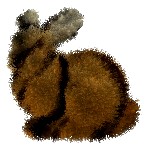
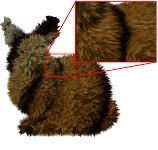
dry fur -----> wet fur --- detail of wet fur
|
The Visual Computer,
(Proc. CGI 2010) Vol.26, No.6-8, pp.883-891, 2010-6
“Visual Simulation of Mixed-motion Avalanches with Interactions
Between Snow Layers"
by Yusuke Tsuda, Yonghao Yue, Yoshinori Dobashi, Tomoyuki Nishita
Abstract
In the field of computer graphics, simulation of
fluids, including avalanches, is an important research topic.
In this paper, we propose a method to simulate a kind of
avalanche, mixed-motion avalanche, which is usually large
and travels down the slope in fast speed, often resulting in
impressive visual effects. The mixed-motion avala- nche consists
of snow smokes and liquefied snow which form an upper
suspension layer and a lower dense-flow layer, respectively.
The mixed-motion avalanche travels down the surface
of the snow-covered mountain, which is called accumulated
snow layer.We simulate a mixed-motion avalanche
taking into account these three snow layers. We simulate
the suspension layer using a grid-based approach, the denseflow
and accumulated snow layer using a particle-based approach.
An important contribution of our method is an interaction
model between these snow layers that enables us to
obtain the characteristic motions of avalanches, such as the
generation of the snow smoke from the head of the avalanche.
Additional information
The IEICE Transactions of Information and Systems (Japanese edition),
D, Vol.J92-D, No.9 pp.1613-1620, 2009-9 (in Japanese)
“Dual-quaternion Skinning with Scaling"
see
The Journal of IIEEJ, Volume 38, pp.1108-116 (in Japanese) 2009-7
"Calculation and Interpolation of Reflectance and Transmittance Distribution
of Scattering Materials
"
see
The Journal of IPSJ,
vol. 17, pp.180-190 (2009). (in Japanese)
"Rendering Translucent Materials with Plane-parallel Solution"
see
The Journal of IPSJ,
Vol.50, No.8, pp.1917-1925, 2009-8 (in Japanese)
"Inverse Problem Approach for BRDF Modeling"
see
IEICE Transactions on Information and Systems,
Vol.E92-D, No.6, pp.1289-1295, 2009-6
“Interactive Region Matching for 2D Animation Coloring Based
on Feature's Variation"
by Pablo GARCIA TRIGO, Henry JOHAN, Takashi IMAGIRE and Tomoyuki Nishita
Abstract
We propose an interactive method for assisting the coloring
process of 2D hand-drawn animated cartoons. It segments input
frames (each hand-drawn drawing of the cartoon) into regions
(areas surrounded by closed lines. E.g. the head, the hands)
extracts their features, and then matches the regions between
frames, allowing the user to fix coloring mistakes interactively.
Its main contribution consists in storing matched regions in
lists called "chains" for tracking how the region features vary
along the animation. Consequently, the matching rate is
improved and the matching mistakes are reduced, thus reducing
the total effort needed until having a correctly colored cartoon.
Key words:
2D animation, coloring, matching
Additional information
The Journal of Visualization and Computer Animation
Volume 20, issue 3-4 (CASA 2009), 2009-6
"Deformation and fracturing using adaptive shape matching with
stiffness adjustment"
by Makoto Ohta, Yoshihiro Kanamori, Tomoyuki Nishita
Abstract
This paper presents a fast method that computes deformations with fracturing of an object
using a hierarchical lattice. Our method allows numerically stable computation based on
so-called shape matching. During the simulation, the deformed shape of the object and the
condition of fracturing are used to determine the appropriate detail level in the hierarchy of
the lattices. Our method modifies the computation of the stiffness of the object in different
levels of the hierarchy so that the stiffness is maintained uniform by introducing a stiffness
parameter that does not depend on the hierarchy. By merging the subdivided lattices, our
method minimizes the increase of computational cost.
KEY WORDS: interactive deformation; soft body; shape matching; fracturing
Additional information
The Visual Computer, 25,
(Proc. of CGI2009), pp.719-727, 2009-6.
"A Fast Method for Simulating Destruction and the Generated Dust
and Debris"
by Takashi Imagire, Henry Johan, Tomoyuki Nishita
Abstract
Simulating the destruction of objects due to collisions has many
applications in computer graphics. Previous methods on the destruction
of objects perform physically-based simulation of the fracture of
objects into relatively large size fragments. However, if we observe
the process of the destruction of objects, we can see that dust and
fine debris are also generated. In particular, previous methods do not
take into account the dust generation. In this paper, we present a
unified framework for simulating destruction and the generated dust
and various sizes of debris. Our method simulates destruction on three
different scales: coarse fracture, fine debris and dust. We compute
the distribution and the amount of fine debris and dust based on the
fracture energy which is the energy that causes the object to be
fractured.We demonstrate the effectiveness of the proposed method, in
terms of the generated effects and the simulation speed, by showing
the simulation results of destruction caused by the collision between
objects.
Additional information
Proc. of GRAPP 2009, pp,129-136, 2009-2.
"AN INVERSE PROBLEM APPROACH TO BRDF MODELING"
by Kei Iwasaki, Fujiichi Yoshimoto, Tomoyuki Nishita and Yoshinori Dobashi
Abstract
This paper presents a BRDF modeling method, based on an inverse problem
approach. Our method calculates
BRDFs to match the appearance of the object specified by the user. By
representing BRDFs by a linear combination
of basis functions, outgoing radiances of the object surface can be
represented using basis functions.
The calculation of the desired BRDF results from calculating the
corresponding coefficients of basis functions
that minimize the sum of differences between the outgoing radiances,
represented using basis functions and
user specified radiances. The properties that BRDFs must satisfy are
described by linear constraint conditions.
This minimization problem can be solved, interactively, using a linearly
constrained least squares approach.
Thus, our method allows the user to design BRDFs directly, under fixed
complex lighting and viewpoint, and
to view the rendering results interactively, under dynamic lighting and
viewpoint.
Additional information
Proc. of CW08, pp., 2008-9.
"Construction of Autostereograms Taking into Account Object Colors and its Applications for Steganography"
by Y. Tsuda, Y, Yue,,Tomoyuki Nishita
Abstract
Information on appearances of three-dimensional objects are transmitted via the Internet, and displaying objects plays an important role in a lot of areas such as movies and video games.
An autostereogram is one of the ways to represent threedimensional objects taking advantage of binocular parallax, by which depths of objects are perceived. In previous methods, the colors of objects were ignored when constructing autostereogram images. In this paper, we propose a method to construct autostereogram images taking into account color variation of objects, such as shading.
We also propose a technique to embed color information in autostereogram images. Using our technique, autostereogram images shown on a display change, and viewers can enjoy perceiving three-dimensional object and its colors in two stages. Color information is embedded in a monochrome autostereogram image, and colors appear when the correct color table is used. Our technique can also be used for steganography to hide color information. Moreover, file size gets smaller than that of an original autostereogram image because indexed colors are used. Therefore, the 3D images constructed using our method are useful for tranmission through the cyberworld.
Additional information
The Visual Computer, Volume 24, Numbers 7-9 pp.753-763, 2008-9.
"A virtual painting knife"
by Naoto Okaichi, Henry Johan, Takashi Imagire1, and Tomoyuki Nishita
Abstract
Recently, in the area of non-photorealistic rendering, there has been a significant effort in digital painting research to simulate traditional painting styles and painting pigments. In particular, the simulation of painting tools is very important because this enables an intuitive painting experience for a user and generates rich painting effects. Many painting systems have been proposed using brushes, but less for other painting tools. As a result, there is still a limitation in the variety of painting effects that can be generated. In this paper, we propose a method to simulate painting using a painting knife, which is an important tool in oil painting. We model a painting knife and model the pigments such that the system is suitable for realizing the impasto style. We also present a technique for simulating the interaction between a painting knife and pigments on a canvas in real-time.
Keywords Non-photorealistic rendering - Painting systems - Painting knife model
Additional information
IECV2007, 2007-11.
"FLUID SIMULATION BY PARTICLE LEVEL SET METHOD
WITH AN EFFICIENT DYNAMIC ARRAY IMPLEMENTATION ON GPU"
by Yasuhiro Matsuda, Yoshinori Dobashi, Tomoyuki Nishita
Abstract
We propose an efficient method to treat dynamic array
data on Graphics Processing Unit (GPU), which is applicable
to fluid simulations. Few numbers of dynamic structures
have been realized on GPU since most of the previous methods
store the data in texture to represent the structure and it
is difficult to manage the dynamic structure on the texture.
Our method uses vertex buffer object for representing the
data structure and combines the transform feedback and the
geometry program, which are the functionalities of GPU.
Our method offers a simple but an efficient way of realizing
dynamic array on GPU. Furthermore we apply our method
to the implementation of a particle level set method. The
particles data are represented by our dynamic array and
they are updated, added, and deleted completely on GPU.
By using the method, a fast and accurate fluid simulation
can be realized.
Additional information
Journal of IIEEJ, Vol.37, No.3 pp.196-205, 2008-5.
"REAL-TIME REFLECTION AND REFRACTION ON A PER-VERTEX BASIS"
by Masanori Kakimoto,Tomoaki Tatsukawa,Geng Chun,Tomoyuki Nishita
Abstract
This paper proposes a novel method for real-time
rendering of polygon mesh surfaces with reflection or
refraction. The basic process is similar to dynamic
environment mapping or cube mapping. Our proposed
method is superior to those in that the accurate ray
direction is reflected in the resulted image at every
vertex on the mesh. Existing real-time techniques suffer
from the differences between the viewpoint for the
environment map and each reflection point. The
proposed method minimizes this by finding an optimal
viewpoint for the reflective or refractive mesh. With a
sufficient number of vertices and map image resolutions,
the users can render reflected images as accurate as ray
tracing for all practical purposes, except for reflected
objects around ray converging points of reflection on
concave surfaces or refraction through convex lenses.
The method can be applied to areas which require
accuracy such as industrial design. Experiments with a
CAD model of a car rear-view mirror and spectacle
lenses exhibited results of sufficient quality for design
verification.
cube mapping suffice. For example, automobile
designers need to check the reflecting image on the rearview
mirror under design and are forced to use ray
tracing. Our method enables them to verify the
reflection/refraction result in real-time.
Additional information
The Visual Computer, Vol. 24, No. 2, pp.77-84. 2008-2.
"GPU-based rendering of point-sampled water surfaces"
by Kei Iwasaki, Yoshinori Dobasi, F.Yoshimoto, Tomoyuki Nishita
Abstract
Particle-based simulations are widely used to simulate fluids.
We present a real-time rendering method for the results
of particle-based simulations of water.
Traditional approaches to visualize the results of
particle-based simulations construct water surfaces
that are usually represented by polygons.
To construct the water surfaces from the results of particle-based
simulations,
a density function is assigned to each particle and a density field is
computed by accumulating the values of the density functions of all
particles.
However, the computation of the density field is time-consuming.
To address this problem, we propose an efficient
calculation of density field using a graphics processing unit (GPU).
We presents a rendering method for water surfaces sampled by points.
The use of the GPU permits efficient simulation of optical effects such
as refraction, reflection, and caustics.
Additional information
Journal for Geometry and Graphics, Volume 11, No. 2, 237-247. 2007-.
"An Educational Non-Photorealistic Rendering System Using 2D Images by Java Programming" Journal for Geometry and Graphics"
by Kunio Kondo, Tomoyuki Nishita, Hisashi Sato, Koichi Matsuda,
Abstract
It is important to improve the teaching and tutoring materials avail-
able in undergraduate CG education. Exposure to such material will certainly help
encourage CG research. However, new image generation algorithms proposed in
recent research are not usually included in tutoring material at the undergraduate
level. We, the authors, have developed teaching material designed for educating
undergraduates in CG. This paper describes teaching materials that support the
study of NPR, or “non-photorealistic processing”, a painting-style image process-
ing technique used in CG education. Our goal is to make a tutoring system for
studying NPR through Java programming. First, we will introduce “Jimmy”, an
educational Java software program for NPR. Jimmy supports a new brush and
filtering functions for painting-style images. Second, we introduce a “CG Ex-
periment Course Syllabus” for using the proposed system, and we describe the
outcomes of its exercises. Students can develop new brush, filtering, and drawing
techniques for painting-style images by extending and modifying the algorithms.
Through using our system we found the following results:
(1) The proposed educational system was very useful for students in compre-
hending an algorithm by extending the existing source of the algorithm, and the
students were able to comprehend various painting processing methods by devel-
oping new image filters.
(2) The proposed educational system spurred an increase in the number of stu-
dents interested in non-photorealistic image generation techniques.
Additional information
PG2007, pp.87-96, 2007-10.
"Global Illumination for Interactive Lighting Design using Light Paths Precomputation and Hierarchical Histogram Estimation"
by Yonghao Yue, K. Iwasaki, Y. Dobashi, Tomoyuki Nishita
Abstract
In this paper, we propose a fast global illumination solution for interactive lighting design. Using our method, light sources and the viewpoint are movable, and the characteristics of materials can be modified (assuming low-frequency BRDF) during rendering. Our solution is based on particle tracing (a variation of photon mapping) and final gathering. We assume that objects in the input scene are static, and pre-compute potential light paths for particle tracing and final gathering. To perform final gathering fast, we propose an efficient technique called Hierarchical Histogram Estimation for rapid estimation of radiances from the distribution of the particles. The rendering process of our method can be fully implemented on the GPU and our method achieves interactive frame rates for rendering scenes with even more than 100,000 triangles.
Additional information
PG2007, pp.363-372, 2007-10.
"Towards Digital Refocusing from a Single Photograph"
by Yosuke Bando, Tomoyuki Nishita
Abstract
This paper explores an image processing method for synthesizing refocused images from a single input photograph containing some defocus blur. First, we restore a sharp image by estimating and removing spatially-variant defocus blur in an input photograph. To do this, we propose a local blur estimation method able to handle abrupt blur changes at depth discontinuities in a scene, and we also present an efficient blur removal method that significantly speeds up the existing deconvolution algorithm. Once a sharp image is restored, refocused images can be interactively created by adding different defocus blur to it based on the estimated blur, so that users can intuitively change focus and depth-of-field of the input photograph. Although information available from a single photograph is highly insufficient for fully correct refocusing, the results show that visually plausible refocused images can be obtained.
Additional information
EGSR2007, pp.35-44, 2007-6.
"Precomputed Radiance Transfer for Dynamic Scenes Taking into Account Light Interreflection"
by Kei Iwasaki, Y. Dobashi, F. Yoshimoto, Tomoyuki Nishita
Abstract
Fast rendering of dynamic scenes taking into account global illumination is
one of the most challenging tasks in computer graphics.
This paper proposes a new precomputed radiance transfer (PRT) method for
rendering dynamic scenes of rigid objects taking into account
interreflections of light between surfaces with diffuse and glossy BRDFs.
To compute the interreflections of light between rigid objects, we consider
the objects as secondary light sources.
We represent the intensity distributions on the surface of the objects with
a linear combination of basis functions.
We then calculate a component of the irradiance per basis function at each
vertex of the object when illuminated by the secondary light source.
We call this component of the irradiance, the basis irradiance.
The irradiance is represented with a linear combination of the basis
irradiances, which are computed efficiently at run-time by using a PRT
technique.
By using the basis irradiance, the calculation of multiple-bounce
interreflected light is simplified and can be evaluated very quickly.
We demonstrate the real-time rendering of dynamic scenes for low-frequency
lighting and rendering for all-frequency lighting at interactive frame
rates.
Additional information
NICOGRAPH International 2007, 2007-5.
"Intuitive Path-based Camera Control for Dynamic Scenes"
by Aritoki Kawai, Tsuneya. Kurihara, Tomoyuki Nishita
Abstract
This paper presents an intuitive user interface for a virtual camera controlled by a path and a set of constraints. Here, the constraints mean where an object is to be projected on the screen. In many cases, the camera position plays a more important role than other settings such as the orientation and the field of view angle of the camera. Therefore, in this paper, the user sets the camera path and the screen constraints, and then, both the orientation and the field of view angle are computed automatically. Thanks to the low computational cost in the presented method, real time control is possible. We generate several sample animations to confirm the effectiveness of this method.
Additional information
The Visual Computing, Volume 23, Issue 9 (CGI07), pp.697 - 705 2007-8.
"A Fast Rendering Method for Clouds Illuminated by Lightning Taking into Account Multiple Scattering"
by Yoshinori Dobashi, Y. Enjyo,T, Yamamoto, Tomoyuki Nishita
Abstract
Methods for rendering natural scenes are used
in many applications such as virtual reality, computer
games, and ?ight simulators. In this paper, we focus on
the rendering of outdoor scenes that include clouds and
lightning. In such scenes, the intensity at a point in the
clouds has to be calculated by taking into account the
illumination due to lightning. The multiple scattering of
light inside clouds is an important factor when creating
realistic images. However, the computation of multiple
scattering is very time-consuming. To address this
problem, this paper proposes a fast method for rendering
clouds that are illuminated by lightning. In the proposed
method, basis intensities are prepared in a preprocess
step. The basis intensities are the intensities at points
in the clouds that are illuminated by a set of point light
sources. In this precomputation, both the direct light
and also indirect light (i.e., multiple scattering) are taken
into account. In the rendering process, the intensities of
clouds are calculated in real-time by using the weighted
sum of the basis intensities. A further increase in speed is
achieved by using a wavelet transformation. Our method
achieves the real-time rendering of realistic clouds illuminated
by lightning.
Additional information
The Visual Computer, Volume 23, Numbers 9-11, pp. 935-944 (CGI2007), 2007-9.
"Anti-Aliased and Real-Time Rendering of Scenes with Light Scattering Effects"
by Takashi Imagire, Henry Johan, Naoki Tamura, Tomoyuki Nishita
Abstract
Recently, for real-time applications such as games, the rendering of scenes
with light scattering effects in the presence of volumetric objects such as sm
oke, mist, etc, has gained much attention. Slice-based methods are well known
techniques for achieving fast rendering of these effects. However, for real-ti
me applications, it is necessary to reduce the number of slice planes that are
used. As a result, aliasing (striped patterns) can appear in the rendered ima
ges. In this paper, we propose a real-time rendering method for scenes contain
ing volumetric objects that does not generate aliasing in the rendered images.
When a scene consists of volumetric and polygonal objects,
the proposed method also does not generate aliasing at the boundaries between
the polygonal and the volumetric objects. Moreover, we are able to reduce alia
sing at shadows inside a volumetric object that are cast by
polygonal objects by interpolating the occlusion rates of light at several loc
ations. The proposed method can be efficiently implemented on a GPU.
Additional information
Proc. ACM Symposium Virtual Reality Software and Technology (VRST) 2006, pp. 91-99 2006-10.
"A Fluid Resistance Map Method for Real-time Haptic Interaction with Fluids"
by Yoshinori Dobashi, S. Hasegawa, M. Kato, M. Sato, T. Yamamoto, Tomoyuki Nishita
Abstract
Under construction
Additional information
TVC; the Visual Computer Journa, Vol.22, No.9-11, p.702 - 712, 2006-10.
"A Practical and Fast Rendering Algorithm for Dynamic Scenes Using Adaptive Shadow Fields"
by Naoki Tamura, Henry Johan, Bing-Yu Chen, Tomoyuki Nishita
Abstract
Recently, a precomputed shadow fields method was proposed to achieve fast rendering of dynamic scenes under environment illumination and local light sources. This method can render shadows fast by precomputing the occlusion information at many sample points arranged on concentric shells around each object and combining multiple precomputed occlusion information rapidly in the rendering step. However, this method uses the same number of sample points on all shells, and cannot achieve real-time rendering due to the rendering computation rely on CPU rather than graphics hardware. In this paper, we propose an algorithm for decreasing the data size of shadow fields by reducing the amount of sample points without degrading the image quality. We reduce the number of sample points adaptively by considering the differences of the occlusion information between adjacent sample points. Additionally, we also achieve fast rendering under low-frequency illuminations by implementing shadow fields on graphics hardware.
Additional information
IEICE06; IEICE 2006, Vol.E89-D, No.9, pp.2562-2571
"Clustering Environment Lights for an Efficient All- Frequency Relighting"
by Henry Johan, Tomoyuki Nishita
Abstract
We present a novel precomputed radiance transfer method for efficient relighting under all-frequency environment illumination. Environment illumination is represented as a set of environment lights. Each environment light comprises a direction and an intensity. In a preprocessing step, the environment lights are clustered into several clusters, taking into account only the light directions. By experiment, we confirmed that the environment lights can be clustered into a much smaller number of clusters than their original number. Given any environment illumination, sampled as an environment map, an efficient relighting is then achieved by computing the radiance using the precomputed clusters. The proposed method enables relighting under very high-resolution environment illumination. In addition, unlike previous approaches, the proposed method can efficiently perform relighting when some regions of the given environment illumination change.
Additional information
CASA06; Proc. CASA 2006, pp.43-52, 2006-7.
"A Controllable Method for
Animation of Earth-scale Clouds"
by Yoshinori Dobashi, Tsuyoshi Yamamoto, Tomoyuki Nishita
Abstract
Computer generated images of the earth are
often used for space flight simulators,
computer games, movies, and so on. Clouds
are indispensable to the creation of realistic
images in these applications. This paper
proposes a method for animating clouds
surrounding the earth. The method allows the
user to control the motion of clouds by
specifying the center positions of high/low
atmospheric pressure areas on the earth’s
surface. This data is used as input data and a
three-dimensional velocity field is then
calculated by solving Navier-Stokes equations.
Water vapor is advected along the velocity
field. Clouds are then generated due to the
phase transition from water vapor to water
droplets. We also propose an interactive
system that enables the user to interactively
control the simulation. The final photorealistic
images are rendered by taking into account
optical phenomena such as the scattering and
absorption of light due to cloud particles.
Additional information
CGI06; Proc. of CGI2006, 2006-
"Real-time Rendering of Particle-based Fluid Simulation"
by Kei Iwasaki, Yoshinori Dobashi, Tomoyuki Nishita
Abstract
In recent years, attention has been paid to particle-based fluid simulation,
with several methods being developed to incorporate particle-based
simulation into CG animations. These methods reconstruct water surfaces that
are usually represented by polygons. However, the computational cost of the
surface reconstruction is quite high. Therefore, it is difficult to render
the result of the particle-based simulation at interactive frame rates. To
address this, we present a real-time method for rendering water surfaces
resulting from particle-based simulation. We present an efficient GPU
accelerated surface reconstruction method from particles, sampling the water
surface point by point. In addition to rendering the point based water
surfaces, the use of the GPU permits efficient simulation of optical effects
such as refraction, reflection, and caustics.
Additional information
NICOGRAPH06; CDROM of NICOGRAPH International2006, 2006-7
"Point-based Rendering of Water Surfaces with Splashes Simulated by Particle-based Simulation"
by Kei Iwasaki, Kaori Ono, Yoshinori Dobashi, Tomoyuki Nishita
Abstract
Creating realistic animations of water is a challenging problem in the field
of computer graphics.
To create realistic animations of water, the fluid simulation of the
movement of water is necessary.
In recent years, attention has been paid to particle-based fluid simulation.
Although several methods have been proposed to render the results of the
particle-based simulation,
there are few methods to render splashes.
This paper presents an efficient rendering method for the results of the
particle-based simulation
with splashes. We calculate the water surfaces and the surfaces of the
splashes
by assigning the density to each particle and extracting iso-surfaces. The
surfaces of the water
and splashes are then sampled by points. This makes it possible to render
the water surfaces
and splashes efficiently by using point-based rendering.
Additional information
NICOGRAPH International 2006, 2006-5.
"A Fast Rendering Method for Shafts of Light in Outdoor Scene"
by Yoshitaka Moro, Ryo Miyazaki, Yoshinori Dobashi, Tomoyuki Nishita
Abstract
Realistic rendering methods of natural phenomena in
real-time have a variety of applications, such as flight simulators
or computer games. The scattering effect due to atmospheric
particles is one of the most important elements in
creating realistic outdoor images. Shafts of light are caused
by objects which shut out the sunlight, such as clouds and
mountains. This paper proposes a method for creating outdoor
images including shafts of light caused by mountains
and clouds. In our method, shafts of light are displayed by
subtracting the intensity of the shielded light. Our method is
accelerated by using the fragment shader, which is a function
of the latest graphics hardware.
Additional information
Computers & Graphics
Volume 30, Issue 5, pp.767-778 2006-10.
"On pixel-based texture synthesis by non-parametric sampling"
by Seunghyup Shin, b, Tomoyuki Nishita and Sung Yong Shin
Abstract
In this paper, we propose a pixel-based method for texture synthesis with non-parametric sampling. On top of the general framework of pixel-based approaches, our method has three distinguishing features: window size estimation, seed point planting, and iterative refinement. The size of a window is estimated to capture the structural components of the dominant scale embedded in the texture sample. To guide the pixel sampling process at the initial iteration, a grid of seed points are sampled from the example texture. Finally, an iterative refinement scheme is adopted to diffuse the non-stationarity artifact over the entire texture. Our objective is to enhance texture quality as much as possible with a minor sacrifice in efficiency in order to support our conjecture that the pixel-based approach would yield high quality images.
Keywords:
Texture synthesis; Image processing; Non-parametric sampling
Additional information
art05; J. of the society for Art and Science pp.145-150, 2005-12
"Progressive 3D Animated Models for Mobile & Web Uses"
by Bing-Yu Chen , Sheng-Yao Cho, Henry Johan,Tomoyuki Nishita
Abstract
To date, more high resolution 3D animated models are required to
present important details and fine structures, however, sometimes
such high resolution models are un-necessary and undesired,
especially on web and mobile phone environments. Though there are
many well-known algorithms dealing well on simplifying 3D models,
most of them are limited to static ones. Applying these mesh
simplification methods to 3D animated models, a good simplified
model in a specified pose can be obtained. However, some features of
the original animated model, which can be shown in other poses, may
be destroyed. In this paper, we propose an automatic method to
simplify a 3D animated model which takes the features shown in every
poses into account and preserves the geometry details of them.
Therefore, a progressive 3D animated model can be generated for
mobile or web uses.
Keywords:
Progressive Animated Models, Animated Model Simplification, LOD
Additional information
vis05; VIS05, pp. 495-502, 2005-10
"A Feature-Driven Approach to
Locating Optimal Viewpoints for Volume Visualization"
by S. Takahashi, I. Fujishiro, Y. Takeshima, Tomoyuki Nishita
Abstract
Optimal viewpoint selection is an important task because
it considerably
influences the amount of information contained in the 2D
projected images of 3D objects, and thus dominates their first impressions
from a psychological point of view. Although several
methods have been proposed that calculate the optimal positions
of viewpoints especially for 3D surface meshes, none has been
done for solid objects such as volumes. This paper presents a new
method of locating such optimal viewpoints when visualizing volumes
using direct volume rendering. The major idea behind our
method is to decompose an entire volume into a set of feature components,
and then find a globally optimal viewpoint by finding a
compromise between locally optimal viewpoints for the components.
As the feature components, the method employs interval
volumes and their combinations that characterize the topological
transitions of isosurfaces according to the scalar field. Furthermore,
opacity transfer functions are also utilized to assign different
weights to the decomposed components so that users can emphasize
features of specific interest in the volumes. Several examples
of volume datasets together with their optimal positions of viewpoints
are exhibited in order to demonstrate that the method can effectively
guide naive users to find optimal projections of volumes.
Keywords:
viewpoint selection, viewpoint entropy, direct volume
rendering, interval volumes, level-set graphs
Additional information
CASA05; CASA05, pp.165-170, 2005-10
"A Fast Rendering Technique of Transparent Objects and Caustics"
by Kei Iwasaki, Fujiichi Yoshimoto, Yoshinori Dobashi, Tomoyuki Nishita
Abstract
Rendering refractive caustics from transparent
objects on opaque objects is computationally intensive.
This paper presents a fast rendering
technique for transparent objects and refractive
caustics due to transparent objects on the opaque
object. To calculate the intensities of caustics,
we set virtual planes around the opaque object
and store the intensities of caustics on the virtual
planes as textures. Caustics are then rendered
by using these textures. Our implementation,
which additionally uses a GPU accelerator,
enables us to render refractive caustics at
interactive frame rates. We demonstrate this interactive
rendering additionally for translation,
rotation of both transparent objects and opaque
objects, as well as for changing light and viewing
directions.
Keywords:
caustics, transparent, refraction,
global illumination, graphics hardwar
Additional information
CGI05; CGI05, pp.148-154
"A Method to Create Colored Pencil Style Images by Drawing Strokes Based on Boundaries of Regions"
by Hajime Matsui, Henry Johan, Tomoyuki Nishita
Abstract
A lot of Non-Photorealistic Rendering methods have been proposed
for creating an artistic image from an image. In this paper, we propose
a method for creating colored pencil style images. The feature
of colored pencil drawings is that, though colored pencil drawings
are drawn with limited number of colors of pencils, we can express
a lot of colors and gentle textures by changing the strengths when
drawing strokes and by overlapping strokes of different colors. In
order to realize this feature, we determine which colors of pencils
to use and how deep to push the pencils (equivalent to the strength
when drawing strokes), then draw several types of strokes, such as
strokes for outlines, basecoats, and shading, allowing the strokes to
overlap each other. When we create strokes for shading, we make
their directions to align along the boundaries of regions, resulting
in images that are more like drawings made by human.
Additional information
IEICE2005; IEICE Transaction,E88-D: Special Issue on CyberWorlds, pp.904-911
"A Method for Fast Rendering of Caustics from Refraction by Transparent Objects"
by Kei Iwasaki, Fujiichi Yoshimoto, Yoshinori Dobashi, Tomoyuki Nishita
Abstract
Caustics are patterns of light focused by reflective or refractive objects.
Because of their visually fascinating patterns, several methods have been developed to render caustics.
We propose a method for the quick rendering of caustics formed by refracted
and converged light through transparent objects.
First, in the preprocess, we calculate sampling rays incident on each vertex of the object, and
trace the rays until they leave the object taking refraction into account.
The position and direction of each ray that finally transmits the
transparent object are obtained and stored in a lookup table.
Next, in the rendering process, when the object is illuminated, the
positions and directions of the rays leaving the object
are calculated using the lookup table.
This makes it possible to render refractive caustics due to transparent objects at interactive frame rates,
allowing us to change the light position and direction,and translate and rotate the object.
Additional information
NICO05; Nicograph International'05, pp.43-48,
"Visual Simulation of Spreading Fire"
by T. Ishikawa, Ryou Miyazaki, Yoshinori Dobashi, Tomoyuki Nishita
Abstract
Visual simulation of fire is used as special effects in movies, applications of fire simulation for the training in disaster prevention. In this paper, we propose techniques for simulating fire spread taking into account the various properties of materials, and for an effective visualization of this phenomenon. In our simulation method, the flame dynamics is ob-tained by combining the Navier-Stokes equations and the heat conduction equation. The various com-bustion processes are simulated by specifying igni-tion points, the thermal diffusivity and calorie of chemical reaction depending on the types of materi-als. Moreover, in our method, fire is extinguished by reducing the fuel concentration. The reduction ratio of the fuel is based on the reaction kinetics theory developed in the field of chemistry. In our fire visu-alization method, the volume representing the fire is considered as a set of point light sources. The inten-sity of objects illuminated by the fire is calculated by accumulating the illumination due to the point light sources.
Additional information
CW2004; Proc. of CW2004 pp. pp.39-44
"A Rapid Rendering Method for Caustics Arising from Refraction by Transparent Objects"
by Kei Iwasaki, Fujiichi Yoshimoto, Yoshinori Dobashi, Tomoyuki Nishita
Abstract
Caustics are patterns of light formed by reflection or refraction of light from objects,
and several methods have been developed to render caustics because of their
visually beautiful patterns.
This paper proposes a method for the rapid rendering of caustics formed by
refracted light through transparent objects.
First, a preprocess is used to generate sampling rays incident on each
vertex of the object, and, taking refraction into account,
to trace the rays until they leave the object.
The position and direction of each ray that finally leaves the transparent
object are obtained and stored in a lookup table.
Next, in the rendering process, when the object is illuminated, the position
and direction of the rays leaving the object
are calculated using the lookup table.
This makes it possible to render refractive caustics due to transparent objects at interactive frame rates
even if the direction of the light changes and the object is translated or rotated.
Additional information
artsci2004; Journal of artsci pp. 207-215
"Creating Watercolor Style Images Taking Into Account Painting Techniques"
by Henry Johan, Ryota Hashimoto, Tomoyuki Nishita
Abstract
Research for creating impressive images like paintings has attained more and
more importance because of the recent growth in processing images. Among many
painting styles, watercolor style gives a strong impression because of its
thin colors and its soft appearance. This paper proposes a method to create
watercolor style images from input images, for instance photographs. In
contrast with the previously proposed watercolor methods that focuses only on
simulating the effects of watercolor medium such as the mottled appearance and
the color glazing, the proposed method also considers how the watercolor
paintings are painted in order to simulate artists' painting techniques. In
the proposed method, artists' painting techniques are represented using
painting rules. Several painting rules are provided, in addition, user can
specify their own painting rules. These painting rules are used for generating
strokes to paint the objects. Painting techniques are simulated by first
detecting the objects in the input image and generating strokes for each
object according to the painting rules. The properties of watercolor medium
are simulated by approximating each stroke with sampling points and diffuses
their color to nearby pixels. Using the proposed method, a user can
interactively create watercolor style images.
Key Words:
Watercolor painting, Painting techniques, Non-Photorealistic Rendering
Additional information
VRST 2004; Proc. of VRST 2004 pp.150 - 153
"An Efficient Representation of Complex Materials for
Real-Time Rendering"
by Wan-Chun Ma , Sung-Hsiang Chao, Bing-Yu Chen,
Chun-Fa Chang, Ming Ouhyoung, Tomoyuki Nishita
Abstract
To make the computer generated imagery (CGI) vivid, analyzing the appearance of materials becomes the first priority. Real world materials usually exhibit complex appearance and cannot be faithfully represented simply by analytical or parametric reflectance functions, such as the combination of bump, glossy, specular and diffuse maps which is widely used in current real-time rendering programs.
In this paper, we propose an appearance representation for general complex materials which can be applied in real-time rendering framework. By combining a single parametric shading function (such as the Phong model) and the proposed spatial-varying residual function (SRF), this representation can recover the appearance of complex materials without much loss of visual fidelity. The difference between the real data and the parametric shading is directly fitted by a specific function for easy reconstruction. It is simple, flexible and easy to be implemented on programmable graphics hardware. We capture real photographs of different materials with a homemade lighting platform and use them to obtain the the data of SRF representation. Experiments show that the mean square error (MSE) between the reconstructed appearance and real photographs is less than 5%.
Additional information
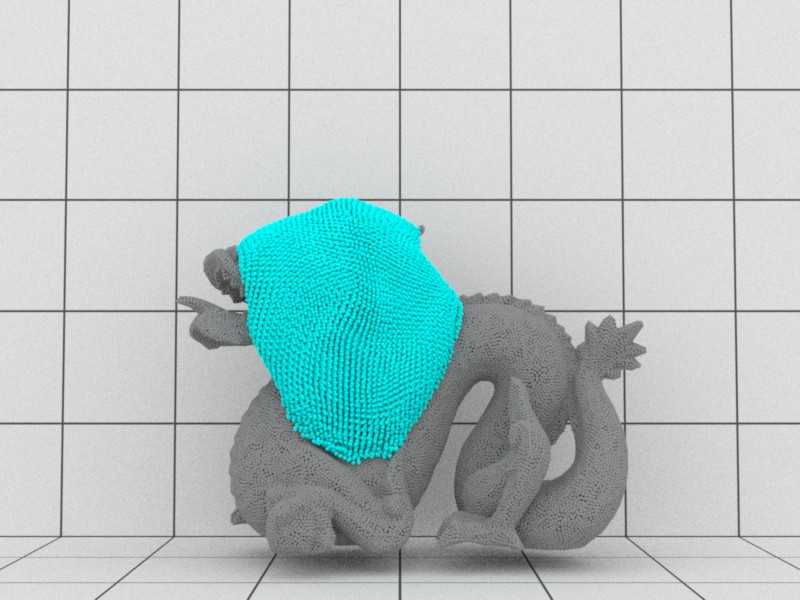
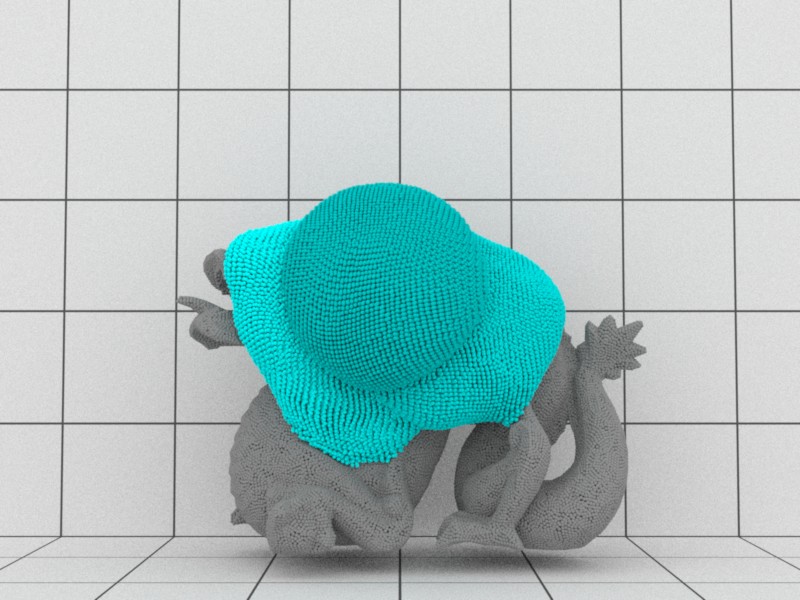
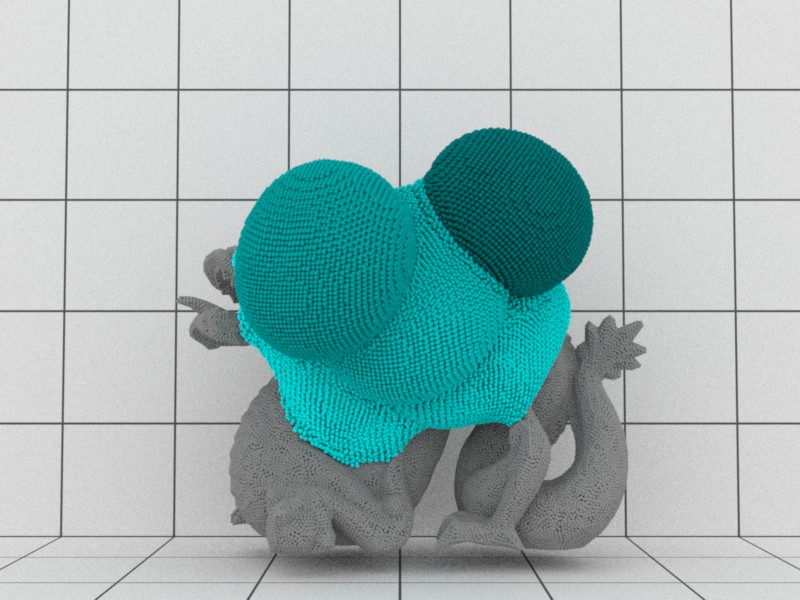
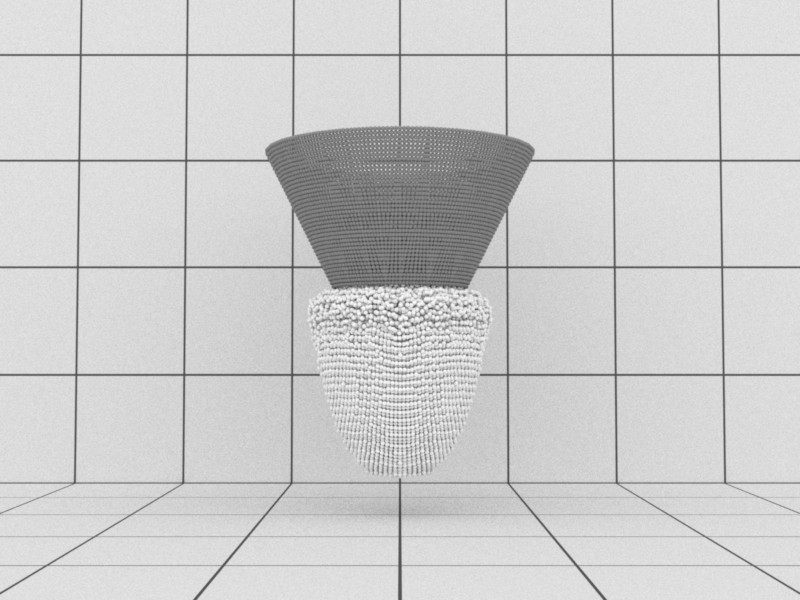
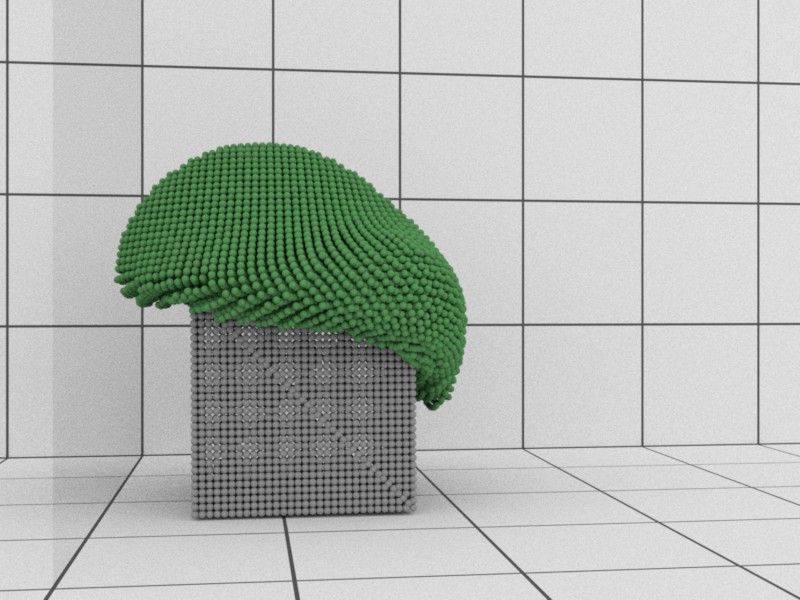




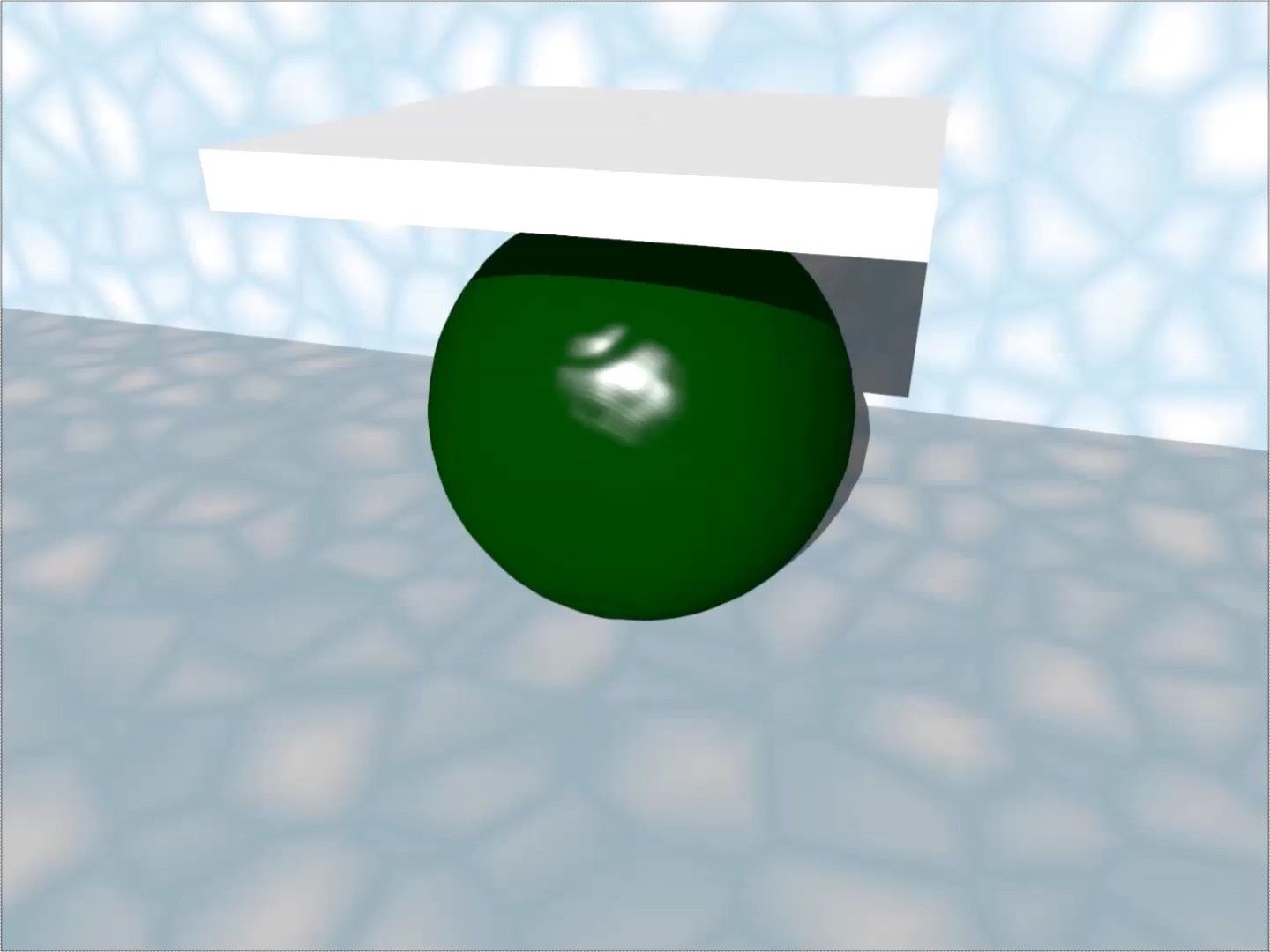
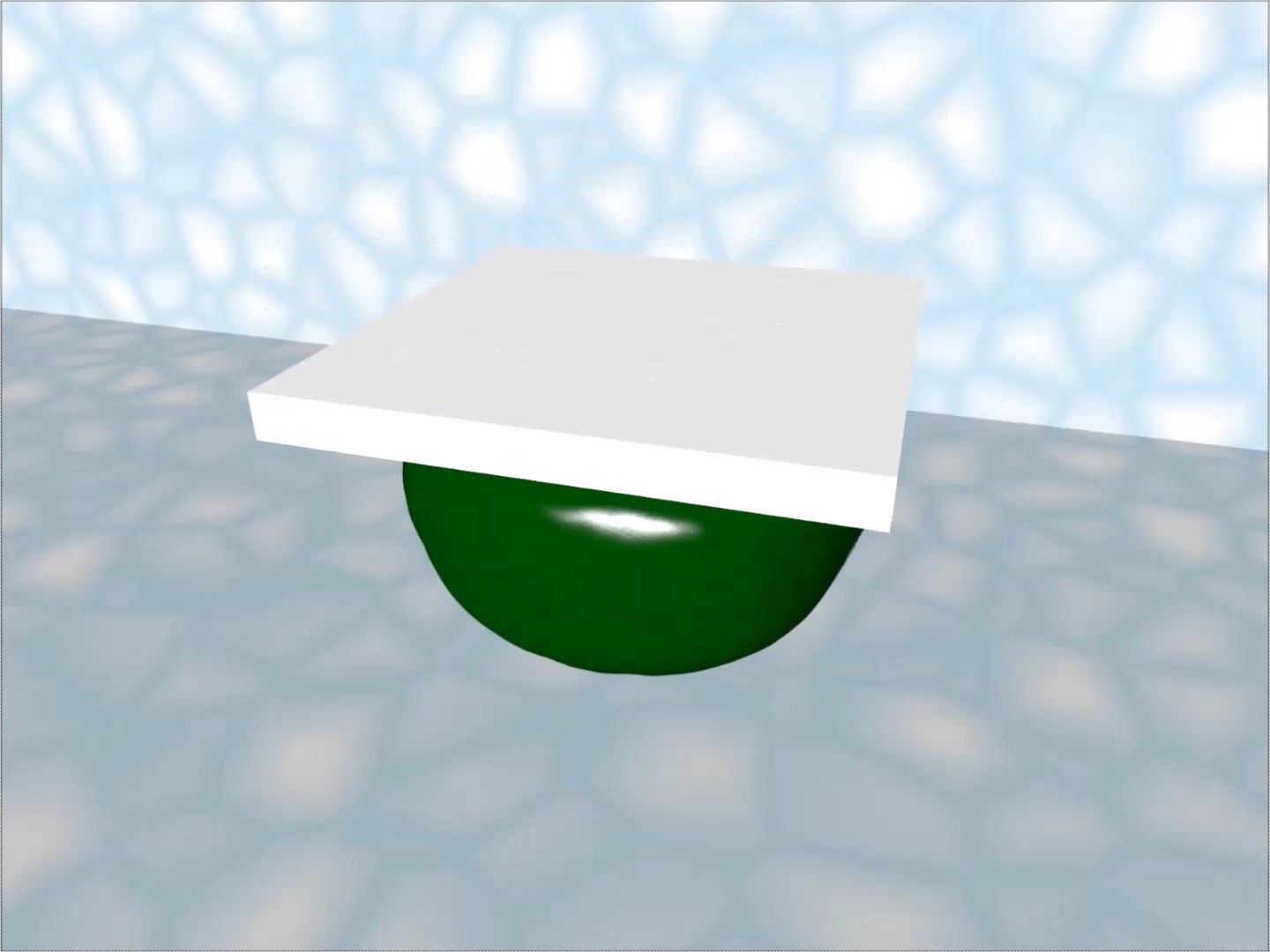
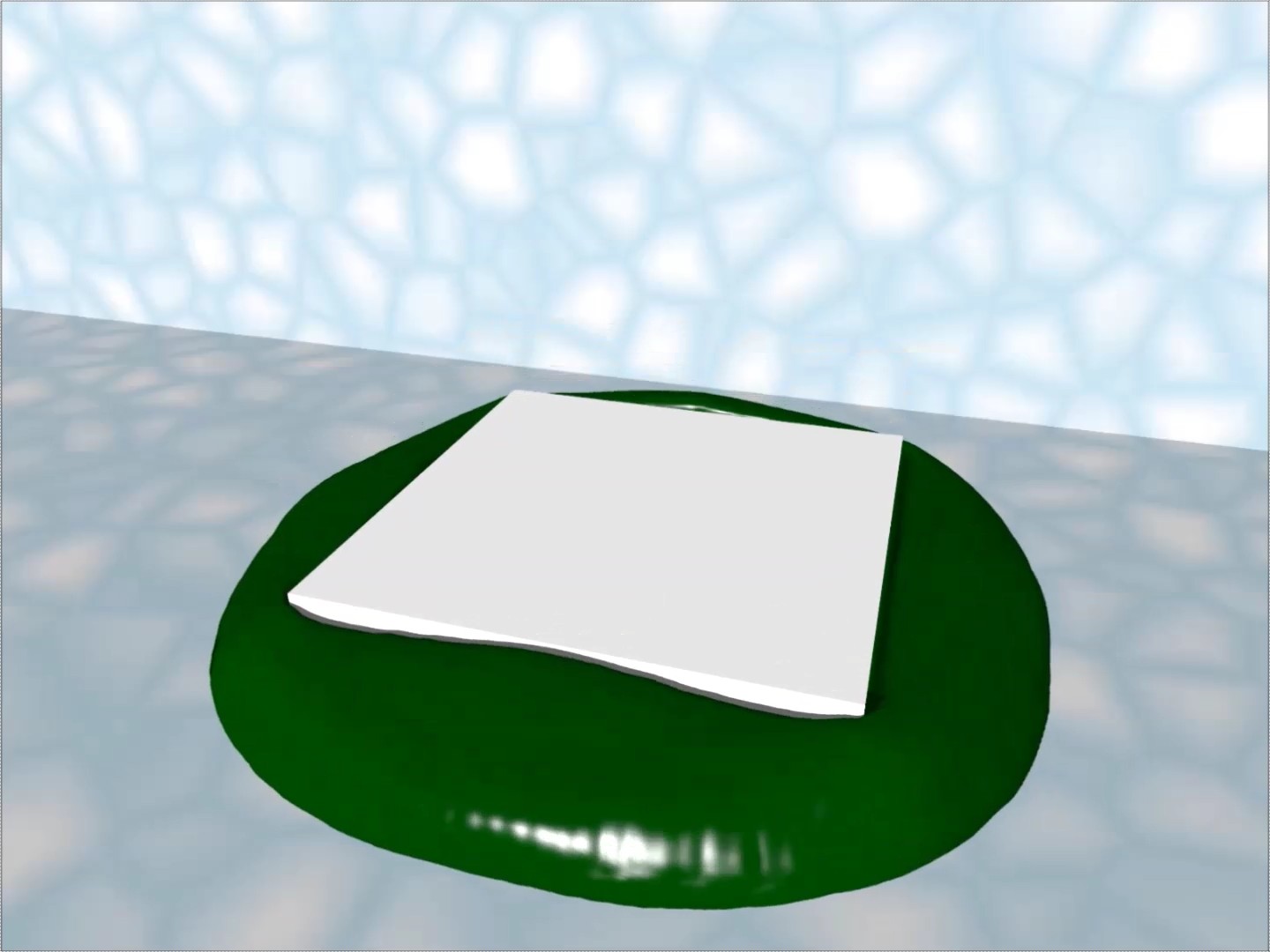
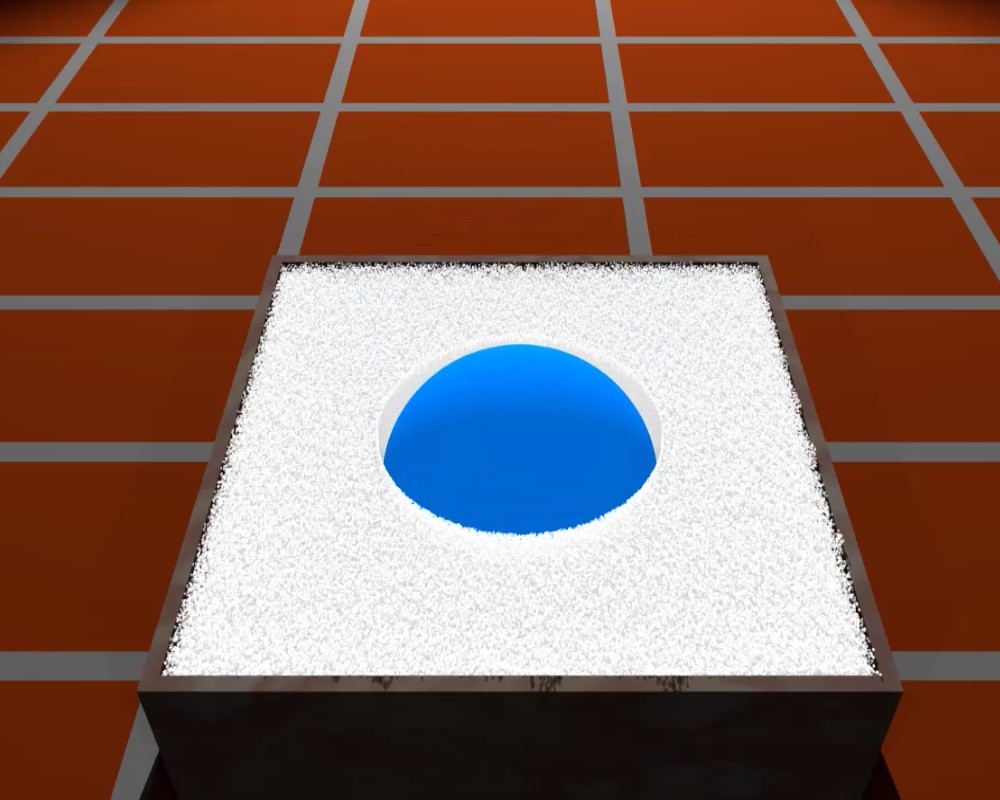
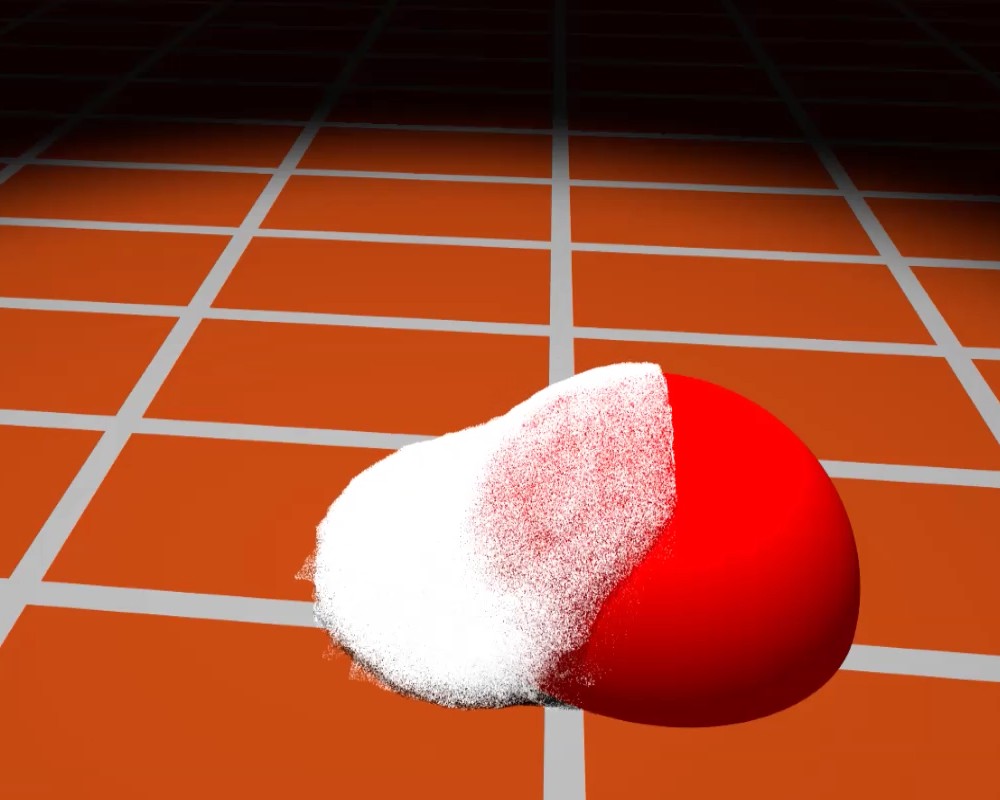
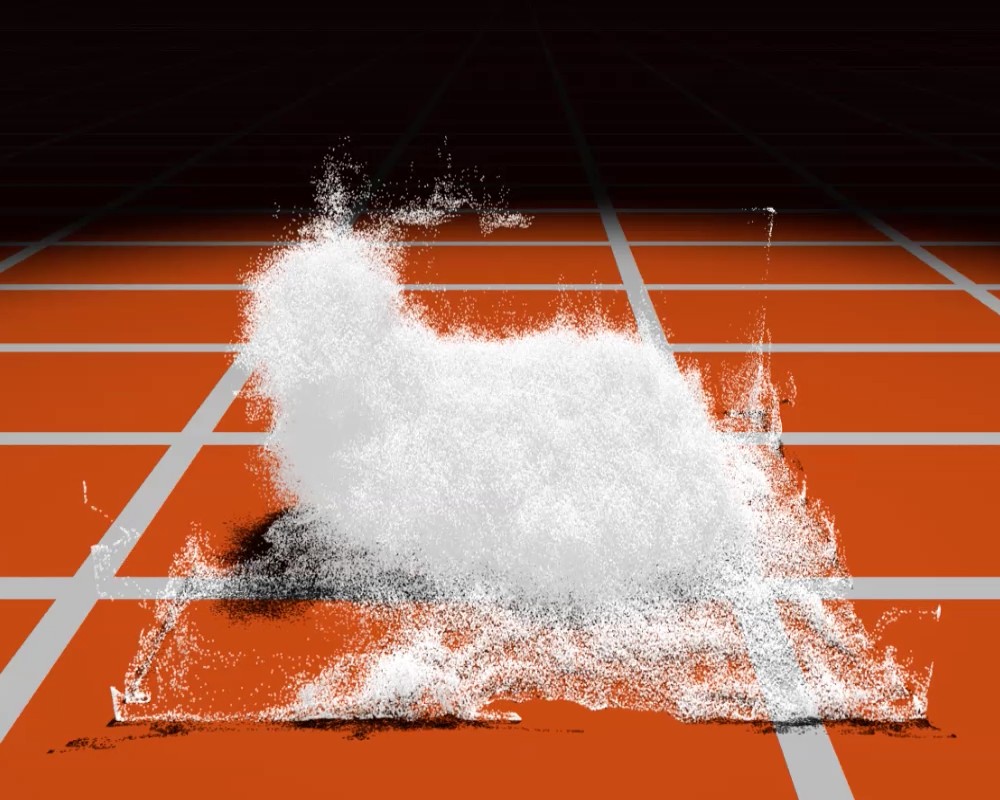
.bmp)
.bmp)
.bmp)
.bmp)










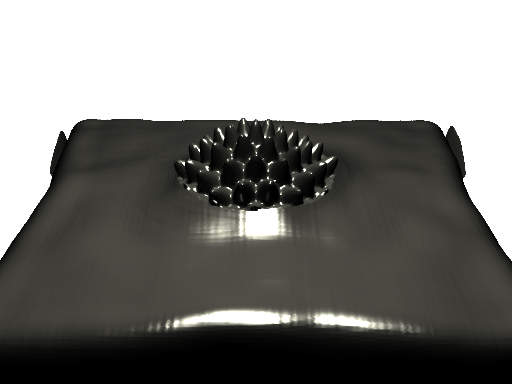
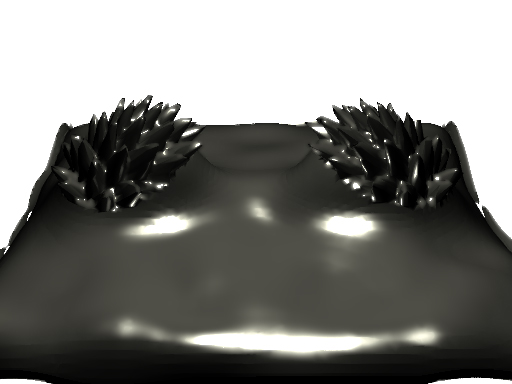
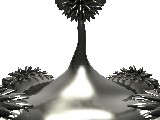








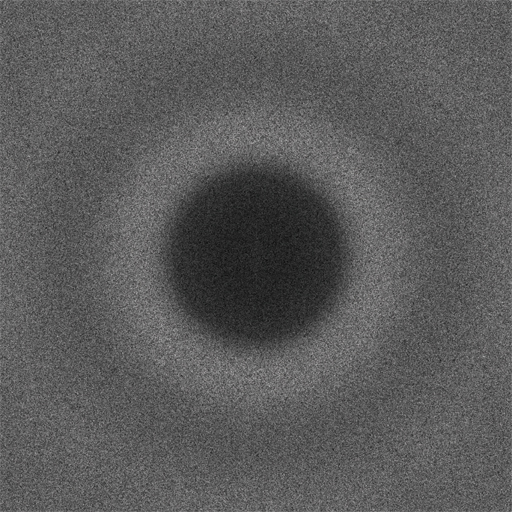
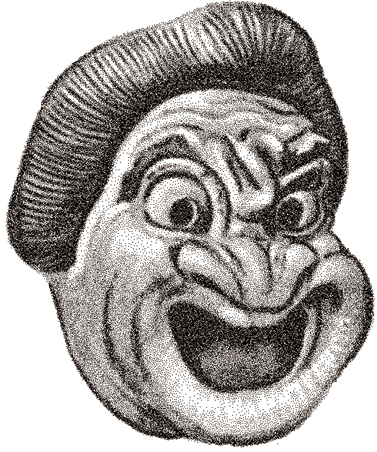
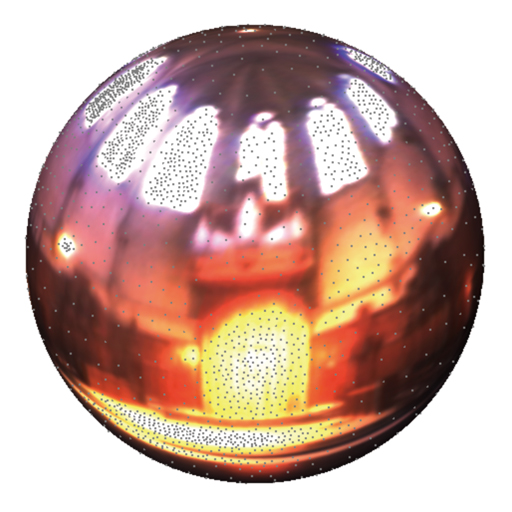
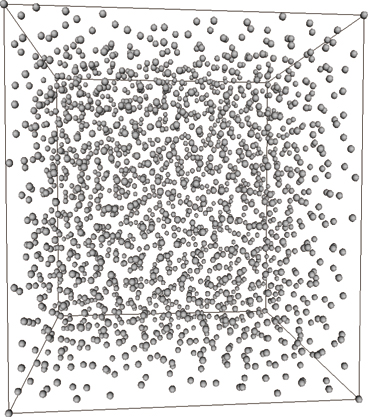



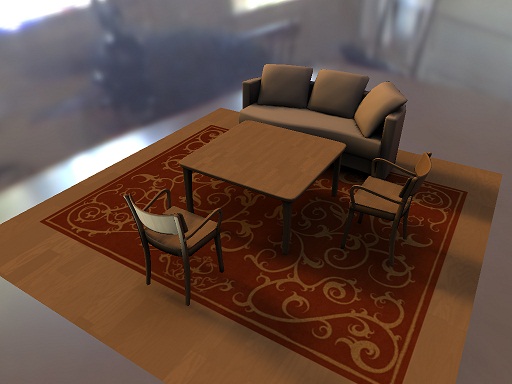
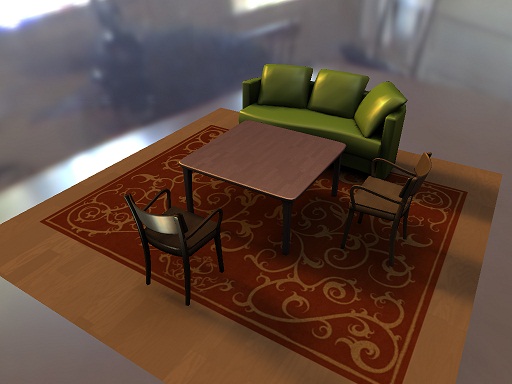
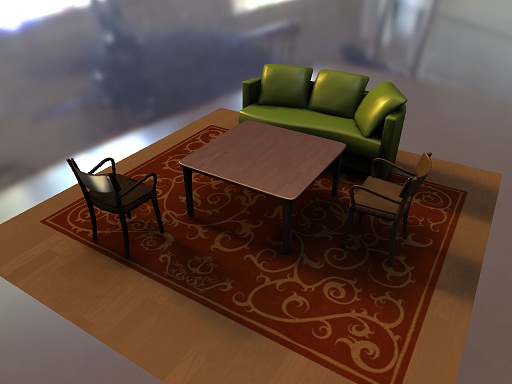


















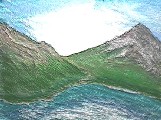
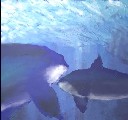
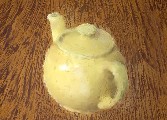
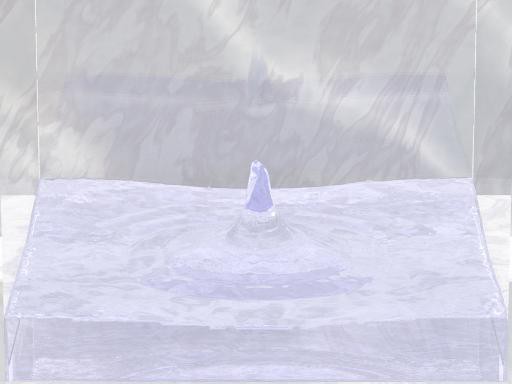


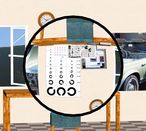

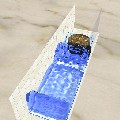
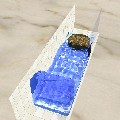












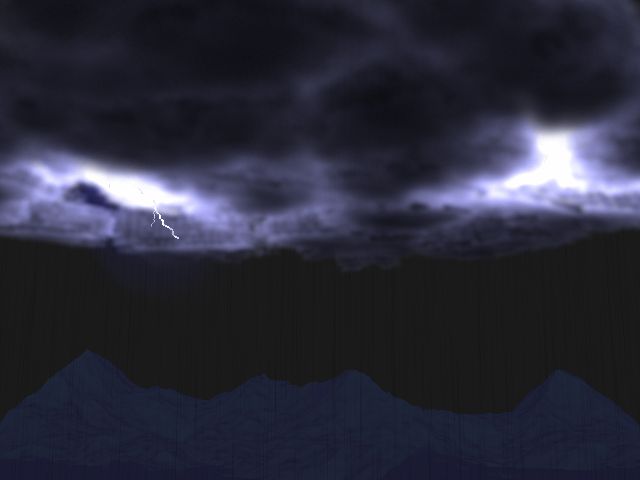
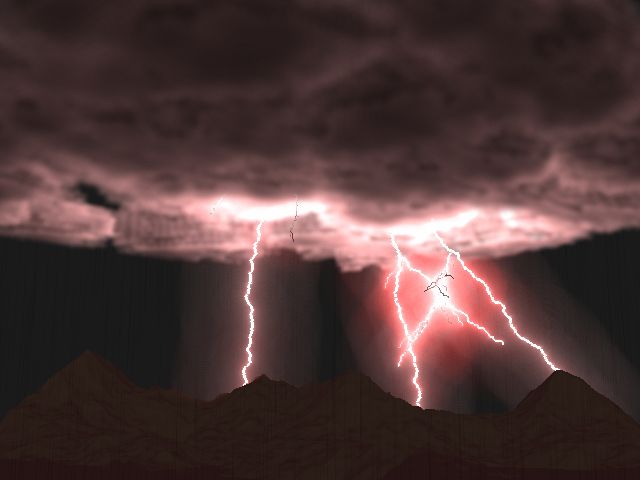
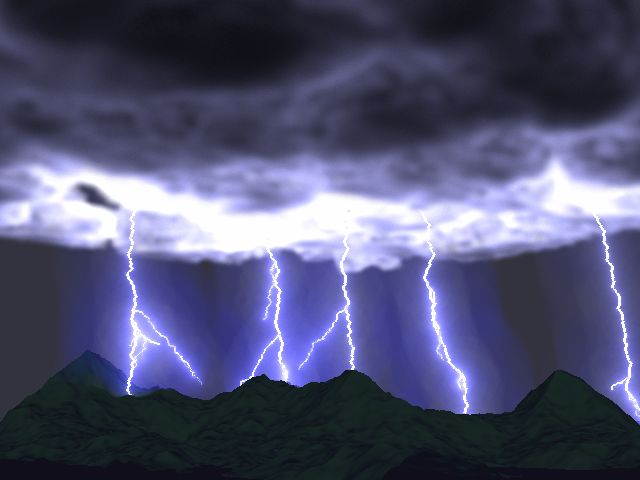






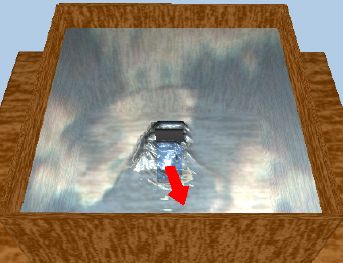
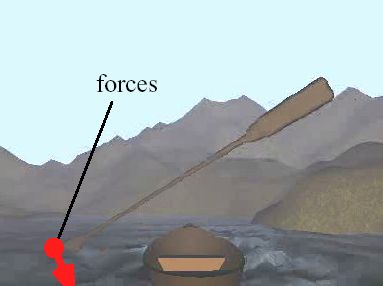
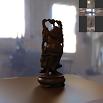
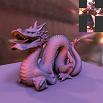
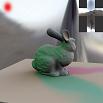



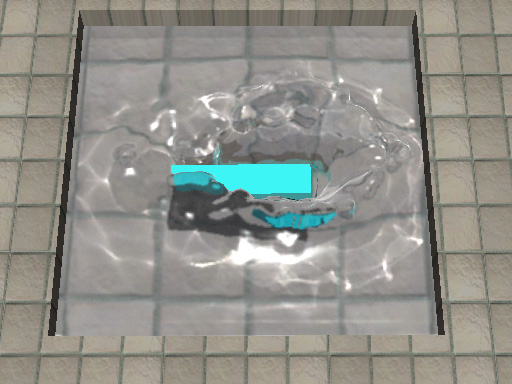
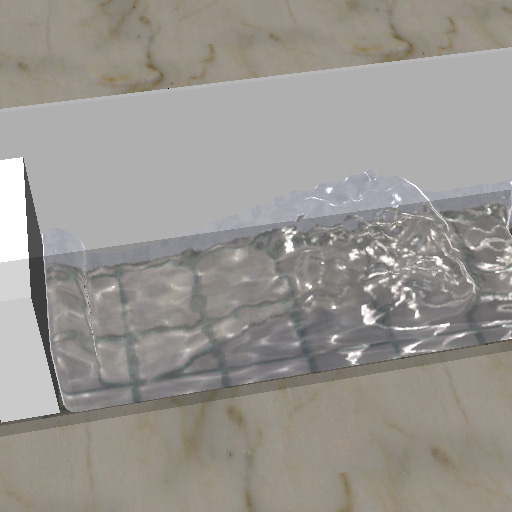
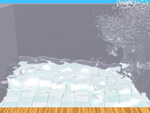
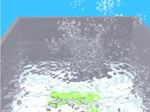

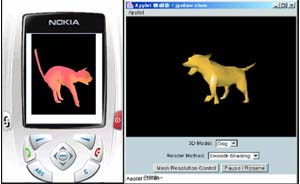
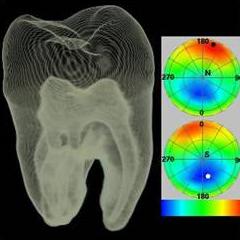
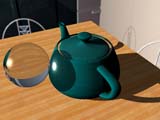

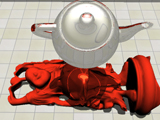

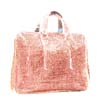
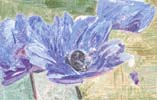
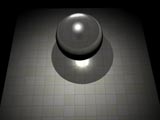
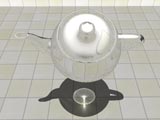
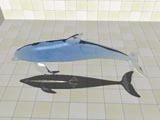
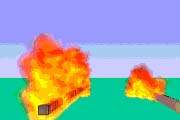
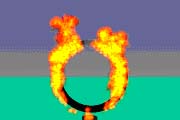
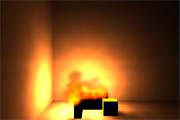
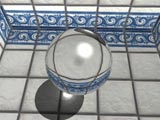
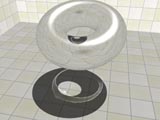
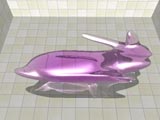


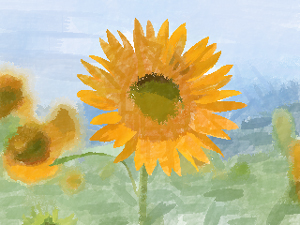
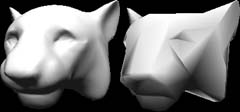

![]() pdf-file (10Mb)
pdf-file (10Mb)
![]() pdf ;(bad qualty))
pdf ;(bad qualty))
![]()
![]() pdf-file (1Mb)
pdf-file (1Mb)
![]() pdf-file (10Mb)
pdf-file (10Mb)
![]() pdf-file with figures (777kb)
pdf-file with figures (777kb)
![]() pdf-file with figures (9Mb)
pdf-file with figures (9Mb)
![]() pdf-file with figures (13Mb)
pdf-file with figures (13Mb)
![]() pdf-file with figures (16Mb)
pdf-file with figures (16Mb)
![]() pdf-file with figures (20.0Mb)
pdf-file with figures (20.0Mb)
![]() pdf-file with figures (19.5Mb)
pdf-file with figures (19.5Mb)
![]() pdf-file with figures (20Mb)
pdf-file with figures (20Mb)
![]() pdf-file
pdf-file
![]()
 Up to my homepage.
Up to my homepage.